Livre des merveilles du monde (Marvels of the World)
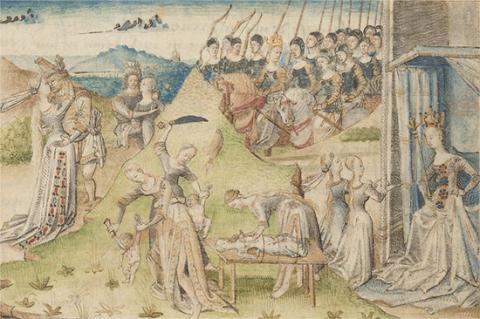
This manuscript contains numerous images of the real and imaginary lands that made up the medieval world. The miniatures are arranged alphabetically and typically focus on the various peoples, exotic costumes, unusual customs, and fantastic creatures of a particular region. Clearly intended to inspire marveling, the depictions are not terrifying or indicative of sin or disaster. Rather, they are designed for and from a Western perspective that considered distant lands and their inhabitants as strange, exotic, and captivating.
Amazons
Livre des merveilles du monde
France, probably Angers, ca. 1460
Purchased by J. Pierpont Morgan (1837-1913) in 1911
MS M.461, fol. 5v (detail)
Thumbnails
Front cover
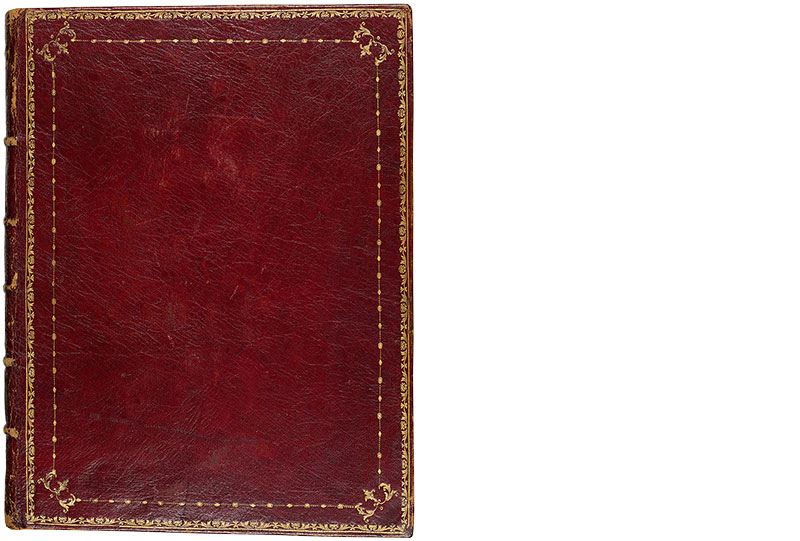
Livre des merveilles du monde
Purchased by J. Pierpont Morgan (1837–1913) in 1911
MS M.461, inside front cover–fol [i]r
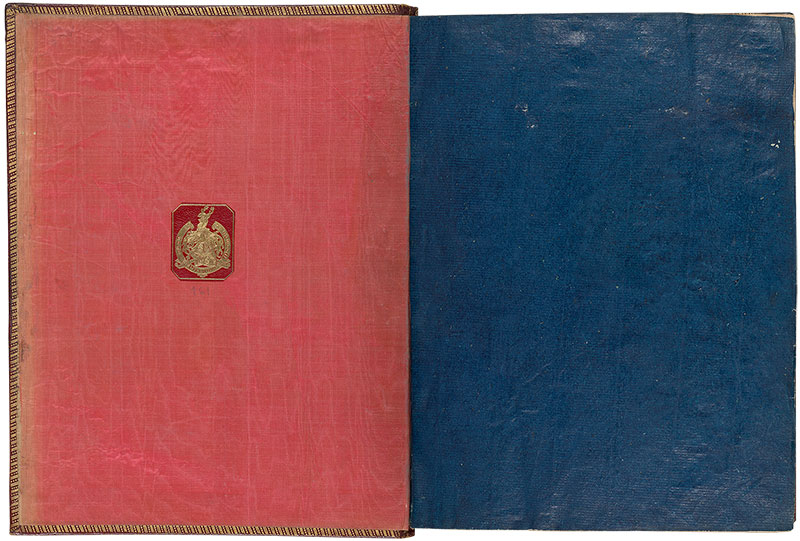
Livre des merveilles du monde
Purchased by J. Pierpont Morgan (1837–1913) in 1911
MS M.461, fols. [i]v–[ii]r
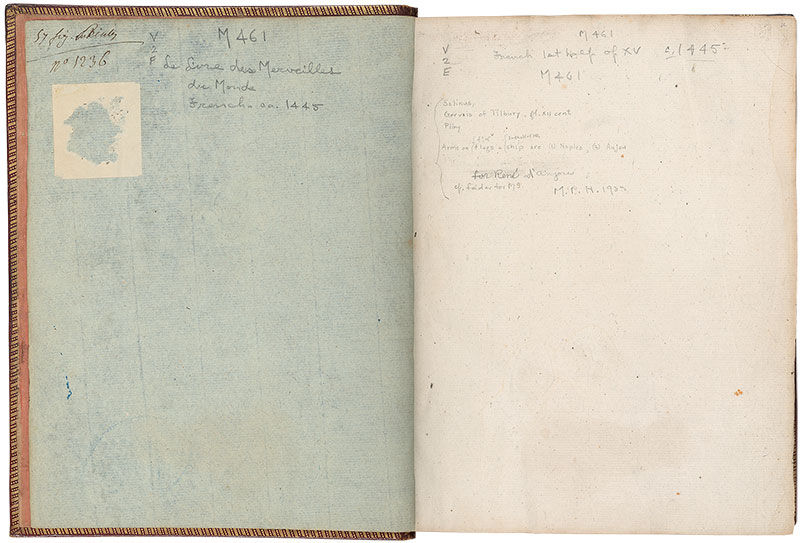
Livre des merveilles du monde
Purchased by J. Pierpont Morgan (1837–1913) in 1911
MS M.461, fols. [ii]v–[iii]r
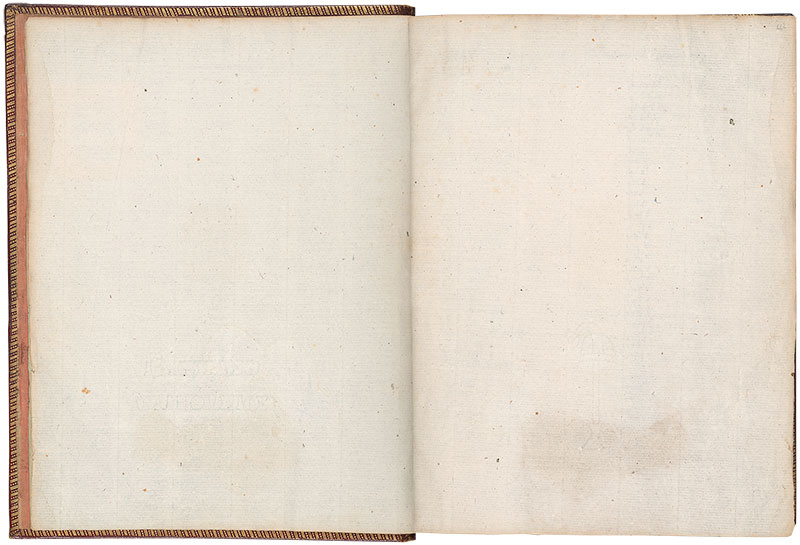
Livre des merveilles du monde
Purchased by J. Pierpont Morgan (1837–1913) in 1911
MS M.461, fols. [iii]v–1r

Livre des merveilles du monde
Purchased by J. Pierpont Morgan (1837–1913) in 1911
MS M.461, fols. 1v–2r
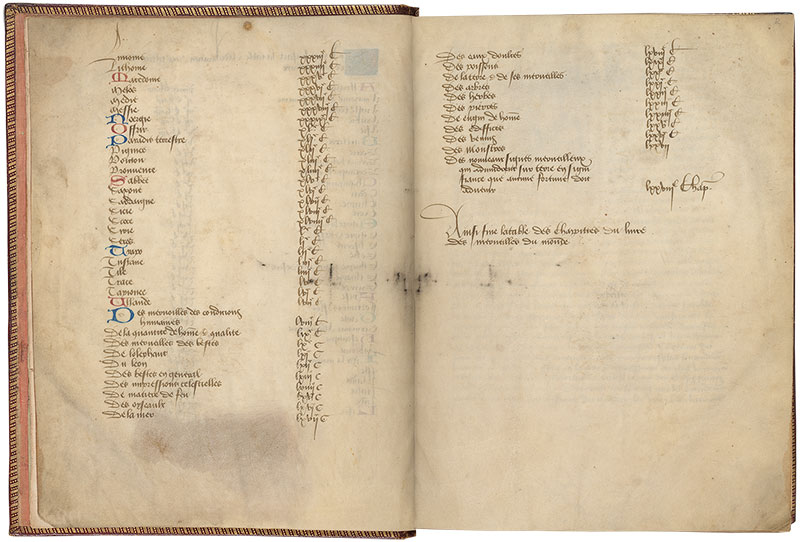
Livre des merveilles du monde
Purchased by J. Pierpont Morgan (1837–1913) in 1911
MS M.461, fols. 2v–3r
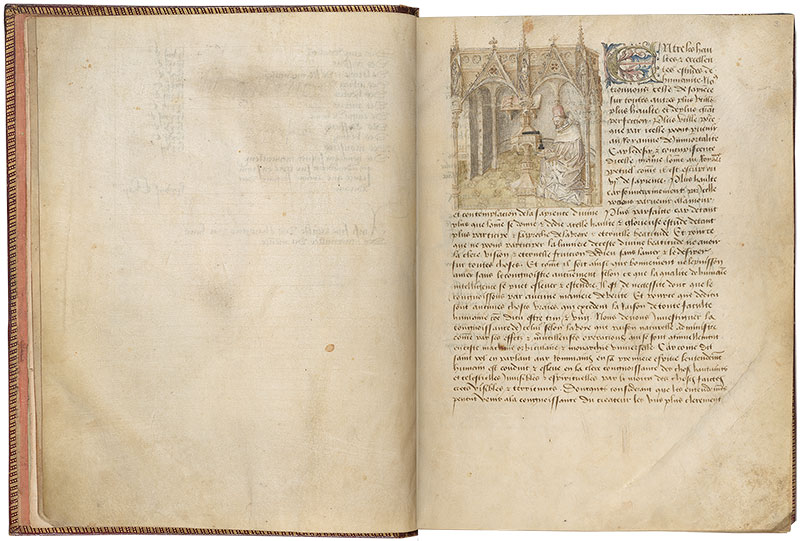
Livre des merveilles du monde
Purchased by J. Pierpont Morgan (1837–1913) in 1911
Author Portrait
While this book is an anonymous compilation made by gathering texts from numerous classical and medieval authors, it nonetheless opens with a generic author portrait, which gives the work a sense of authority.
MS M.461, fols. 3v–4r
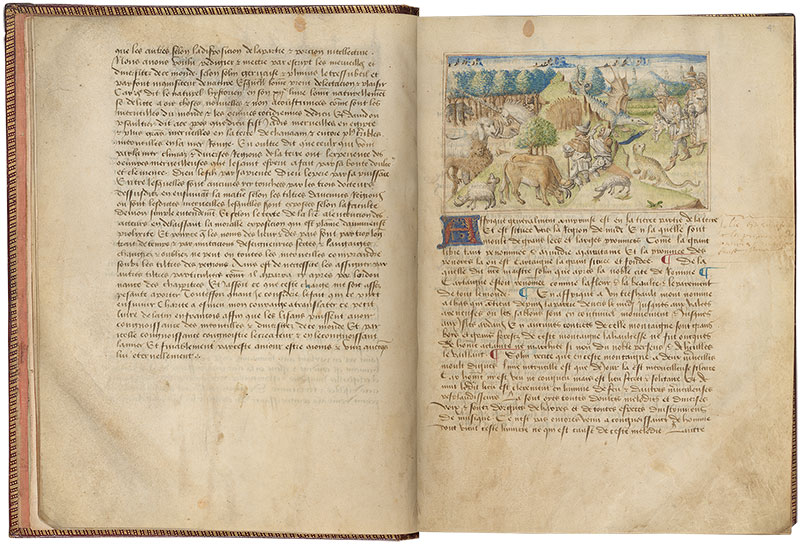
Livre des merveilles du monde
Purchased by J. Pierpont Morgan (1837–1913) in 1911
Africa
This image focuses on the animals of Africa, real and imagined, including a lion, elephant, unicorn, and basilisk. Also featured are a pair of shepherds and members of a tribe that exposes their infants to poisonous lizards to develop their immunity.
MS M.461, fols. 4v–5r

Livre des merveilles du monde
Purchased by J. Pierpont Morgan (1837–1913) in 1911
MS M.461, fols. 5v–6r
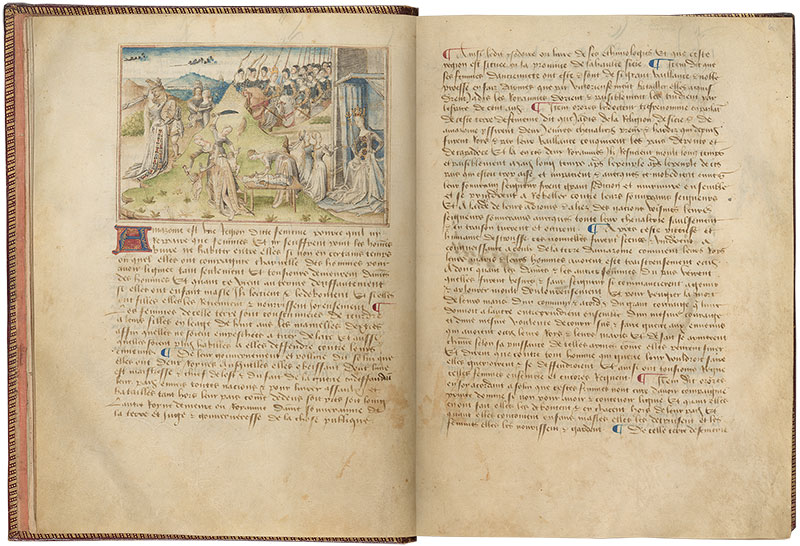
Livre des merveilles du monde
Purchased by J. Pierpont Morgan (1837–1913) in 1911
Amazons
These mythical warrior-women are presented as if they were European noblewomen. They are shown engaged in their legendary behaviors, including mating with men from neighboring tribes and killing all their male offspring.
MS M.461, fols. 6v–7r
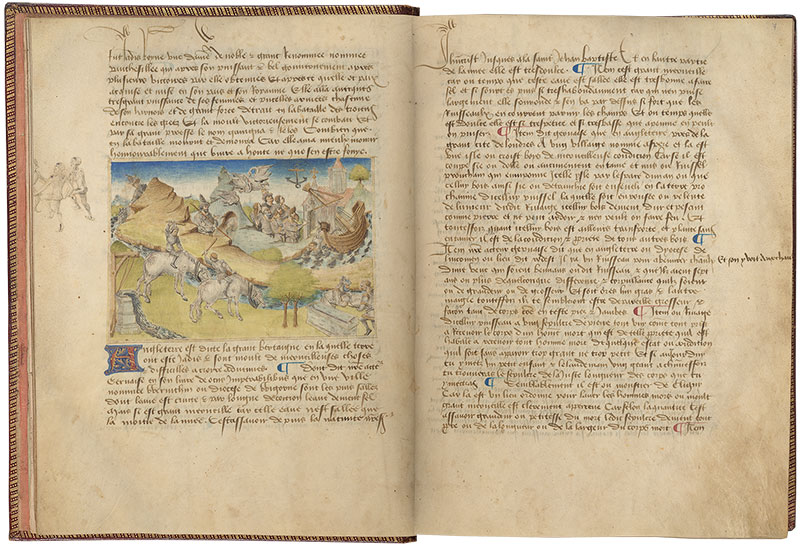
Livre des merveilles du monde
Purchased by J. Pierpont Morgan (1837–1913) in 1911
Great Britain
Even Britain is presented as a land of marvels with healing waters, a cave with a portal to another realm, and a flying ship.
MS M.461, fols. 7v–8r
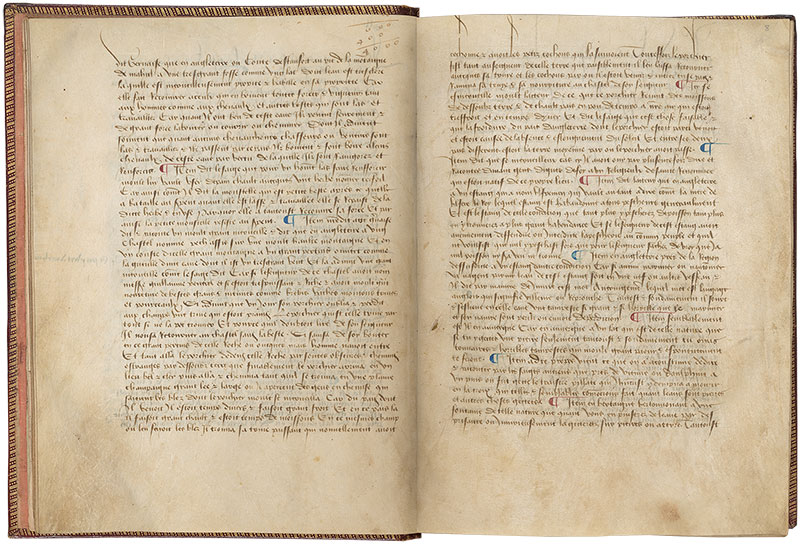
Livre des merveilles du monde
Purchased by J. Pierpont Morgan (1837–1913) in 1911
MS M.461, fols. 8v–9r
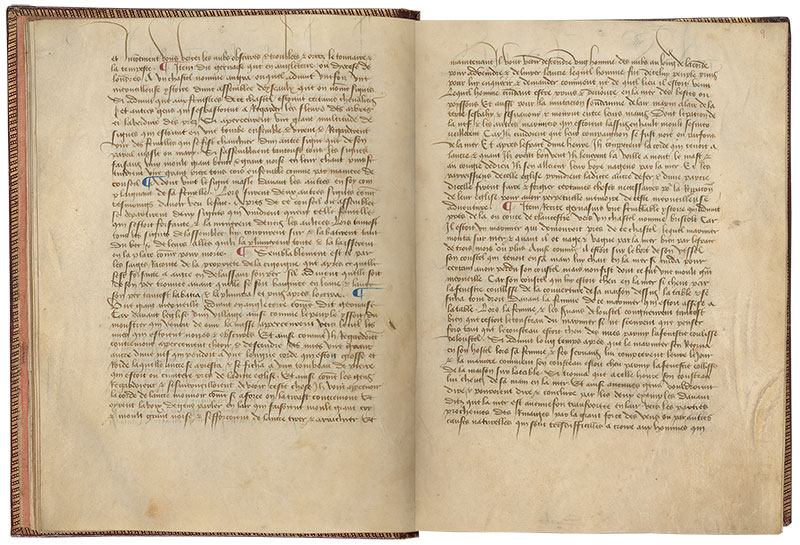
Livre des merveilles du monde
Purchased by J. Pierpont Morgan (1837–1913) in 1911
MS M.461, fols. 9v-10r
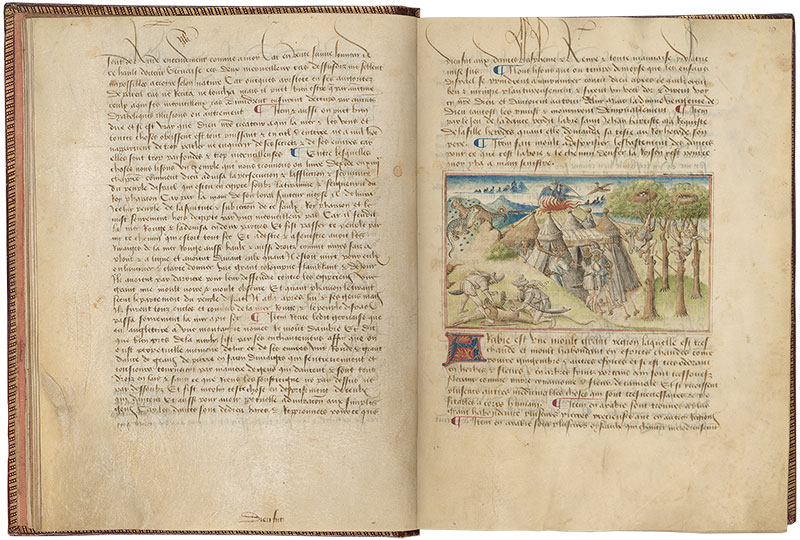
Livre des merveilles du monde
Purchased by J. Pierpont Morgan (1837–1913) in 1911
Arabia
Arabia is presented as a land of wealth and terror; gems are abundant, but they must be pulled from the bellies of dragons.
MS M.461, fols. 10v–11r
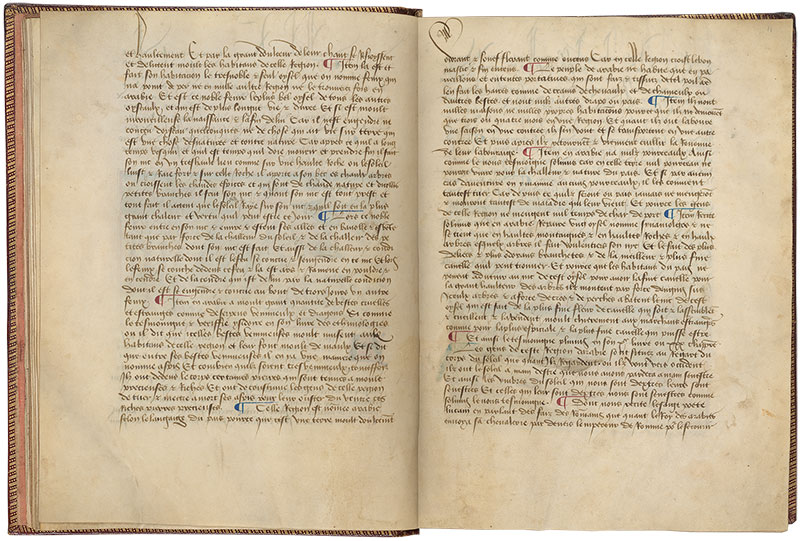
Livre des merveilles du monde
Purchased by J. Pierpont Morgan (1837–1913) in 1911
MS M.461, fols. 11v–12r
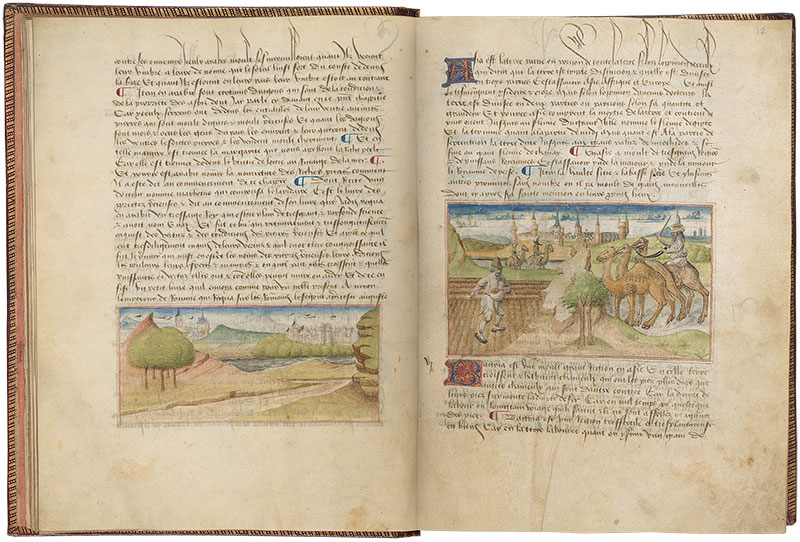
Livre des merveilles du monde
Purchased by J. Pierpont Morgan (1837–1913) in 1911
Asia (left)
This image is unusually bland, showing only a landscape with two towns in the distance.
Bactria (right)
In the Middle Ages, as today, Bactria was famous for its camels, here driven by a turban-wearing man; they are, though, located in what looks to be a typical European town.
MS M.461, fols. 12v–13r
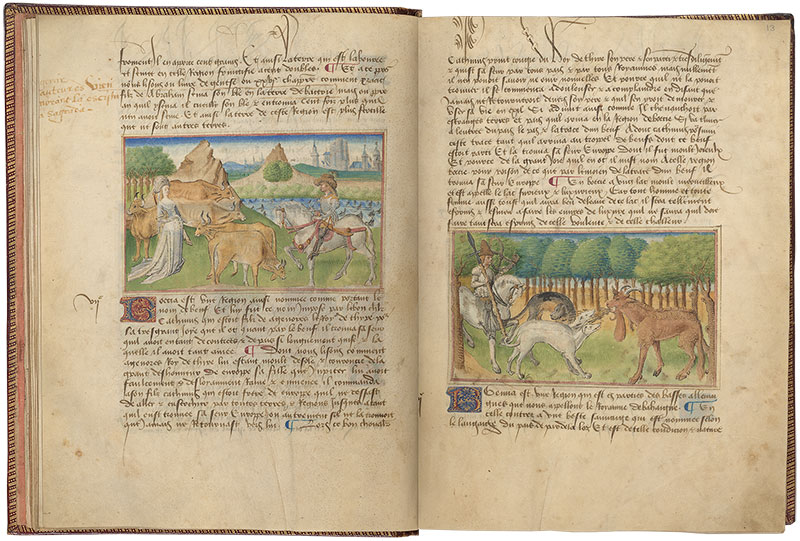
Livre des merveilles du monde
Purchased by J. Pierpont Morgan (1837–1913) in 1911
Boeotia (left)
In a scene from Greek myth, the princess Europa is found by her brother Cadmus, founder of Thebes.
Bohemia (right)
A hunter and his dogs pursue the loz, a beast that boils water in a sac on its neck and then spews the scalding water onto those who attack it.
MS M.461, fols. 13v–14r
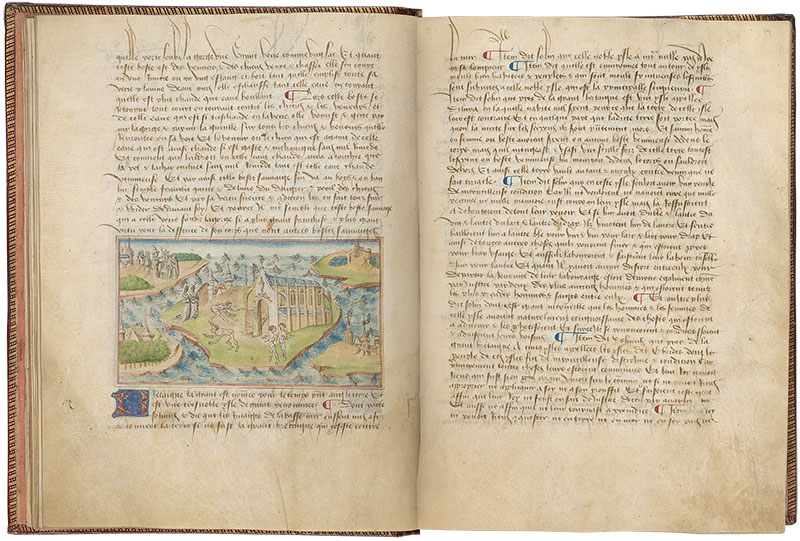
Livre des merveilles du monde
Purchased by J. Pierpont Morgan (1837–1913) in 1911
Britain
Like the first image of Britain in this manuscript, the scene here depicts a strange place filled with men who paint their bodies in many colors and women who paint themselves black so as to travel incognito.
MS M.461, fols. 14v–15r
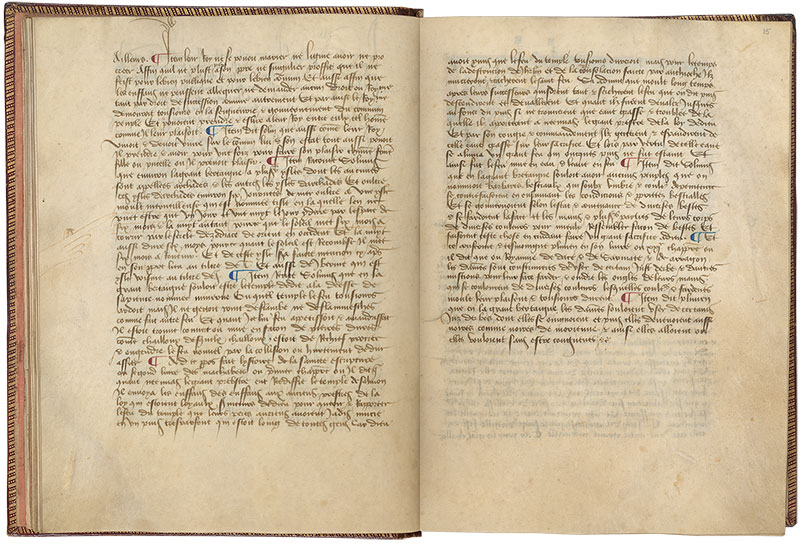
Livre des merveilles du monde
Purchased by J. Pierpont Morgan (1837–1913) in 1911
MS M.461, fols. 15v–16r
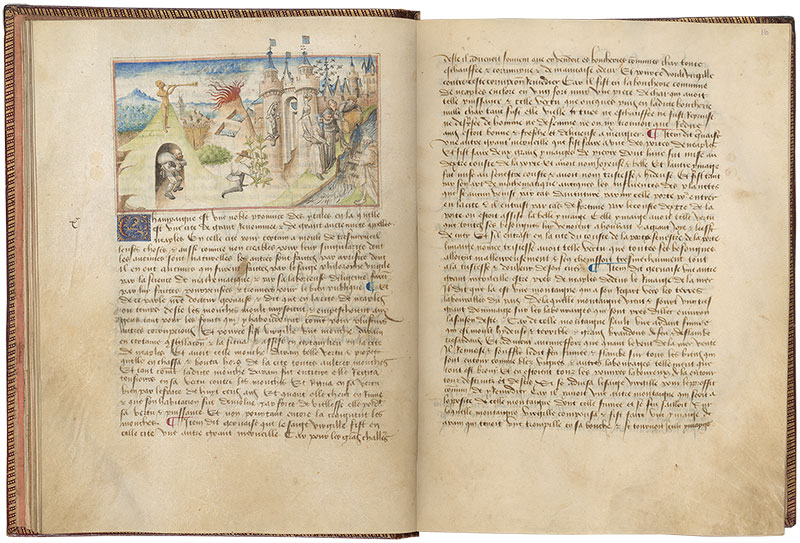
Livre des merveilles du monde
Purchased by J. Pierpont Morgan (1837–1913) in 1911
Campania
This complicated image shows a brass statue blowing a trumpet to signal the eruption of Mt. Vesuvius, which stands beside a city guarded by two images of women, old and young.
MS M.461, fols. 16v–17r
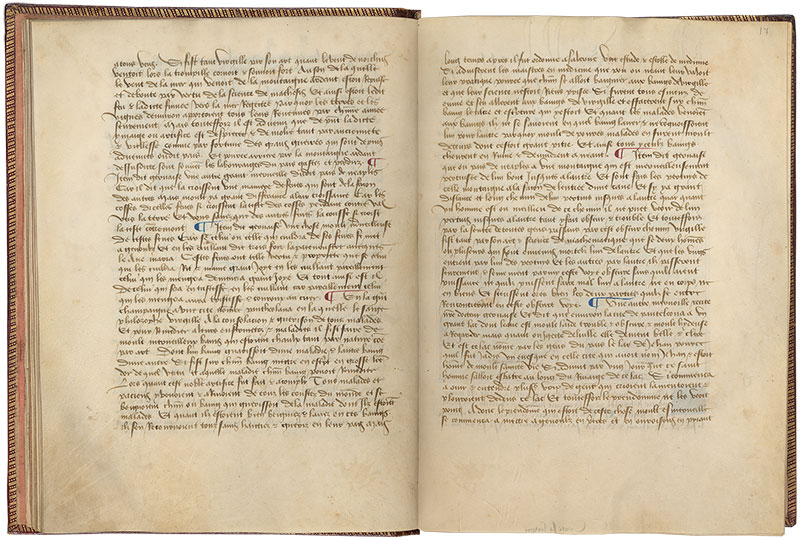
Livre des merveilles du monde
Purchased by J. Pierpont Morgan (1837–1913) in 1911
MS M.461, fols. 17v–18r
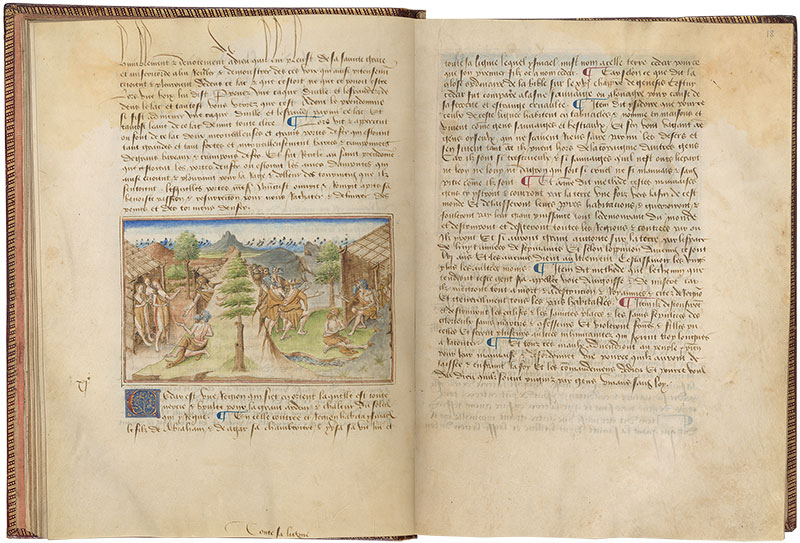
Livre des merveilles du monde
Purchased by J. Pierpont Morgan (1837–1913) in 1911
Qedar
This region is shown as populated by nomads who dress in animal skins and live in temporary shelters.
MS M.461, fols. 18v–19r
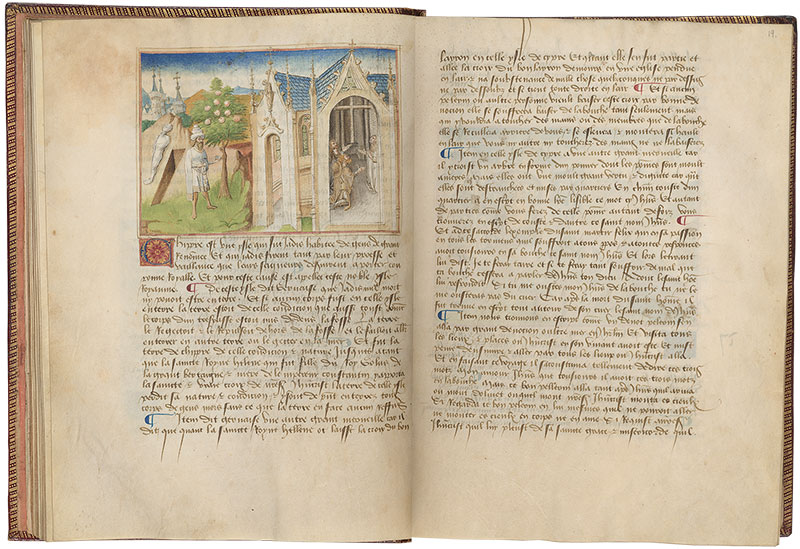
Livre des merveilles du monde
Purchased by J. Pierpont Morgan (1837–1913) in 1911
Cyprus
Here, the marvels are explicitly Christian in nature. The earth rejects the bodies of the dead until Empress Helene brings the True Cross to Cyprus, and the cross of the good thief hangs suspended in the church.
MS M.461, fols. 19v–20r

Livre des merveilles du monde
Purchased by J. Pierpont Morgan (1837–1913) in 1911
Crete
The island is shown as a land of sophisticated and industrious workers and abundant trees.
MS M.461, fols. 20v–21r
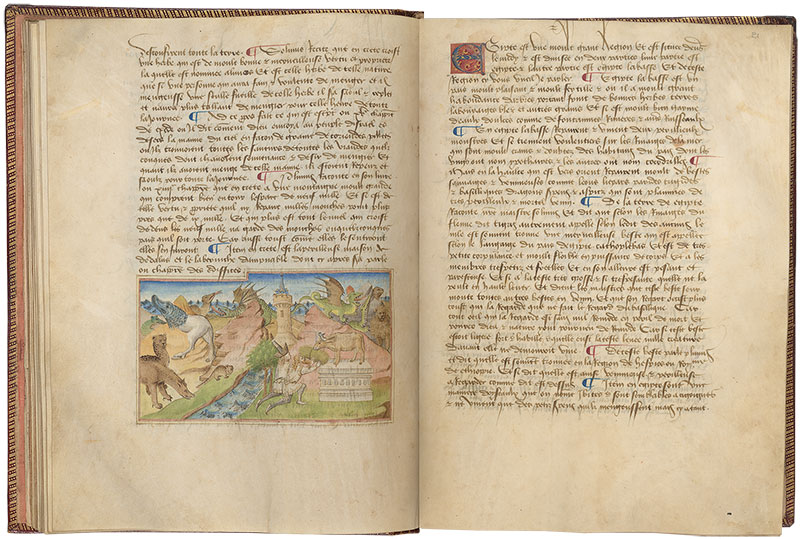
Livre des merveilles du monde
Purchased by J. Pierpont Morgan (1837–1913) in 1911
Egypt
This image shows a land brimming with dangerous monsters, including several types of dragons and a basilisk, and idolatry.
MS M.461, fols. 21v–22r
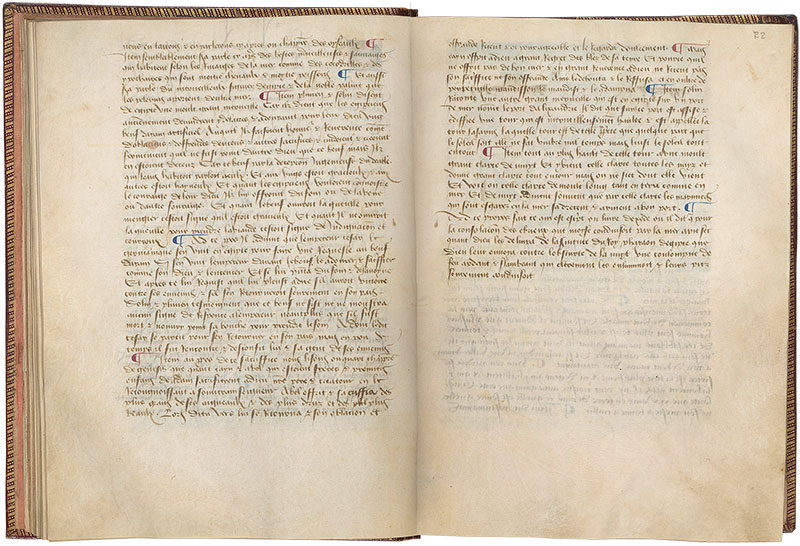
Livre des merveilles du monde
Purchased by J. Pierpont Morgan (1837–1913) in 1911
MS M.461, fols. 22v–23r
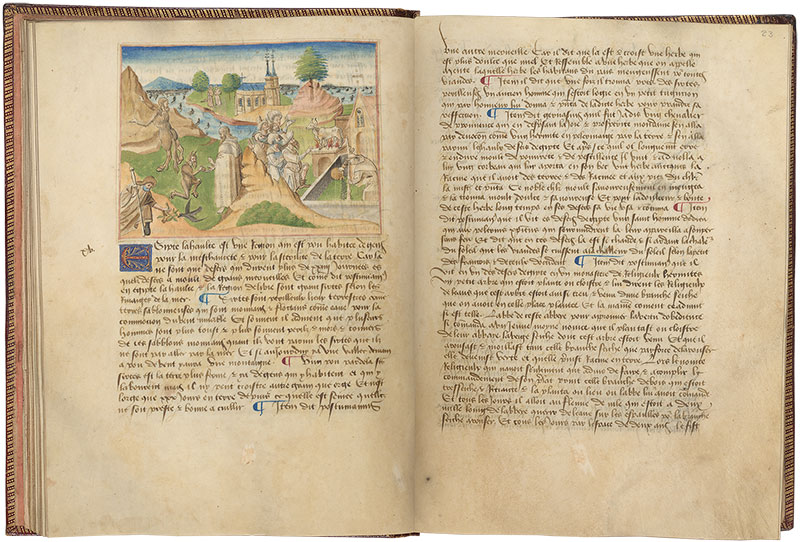
Livre des merveilles du monde
Purchased by J. Pierpont Morgan (1837–1913) in 1911
Egypt
This second image of Egypt reinforces the presentation of the region as monstrous and idolatrous. Mixing time periods freely, it shows a scene of the Israelites worshiping the Golden Calf beside St. Anthony meeting a satyr and centaur.
MS M.461, fols. 23v–24r
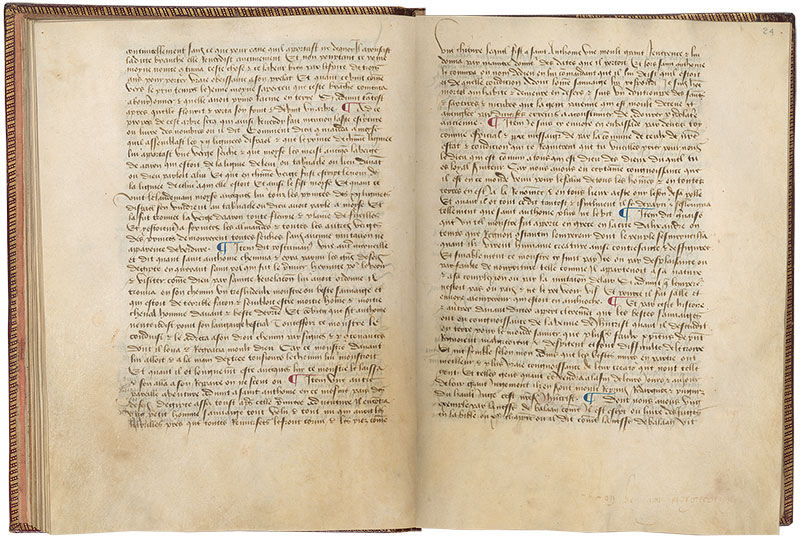
Livre des merveilles du monde
Purchased by J. Pierpont Morgan (1837–1913) in 1911
MS M.461, fols. 24v–25r
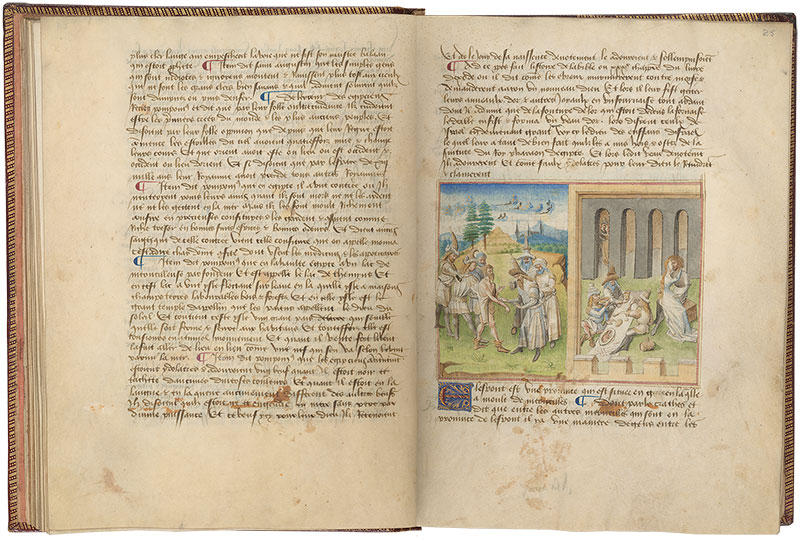
Livre des merveilles du monde
Purchased by J. Pierpont Morgan (1837–1913) in 1911
Hellespont
Hellespont is shown as full of wonder: a place where people can heal with a touch, but also a place of dangerous temptation, where people eat and have sex in public.
MS M.461, fols. 25v-26r
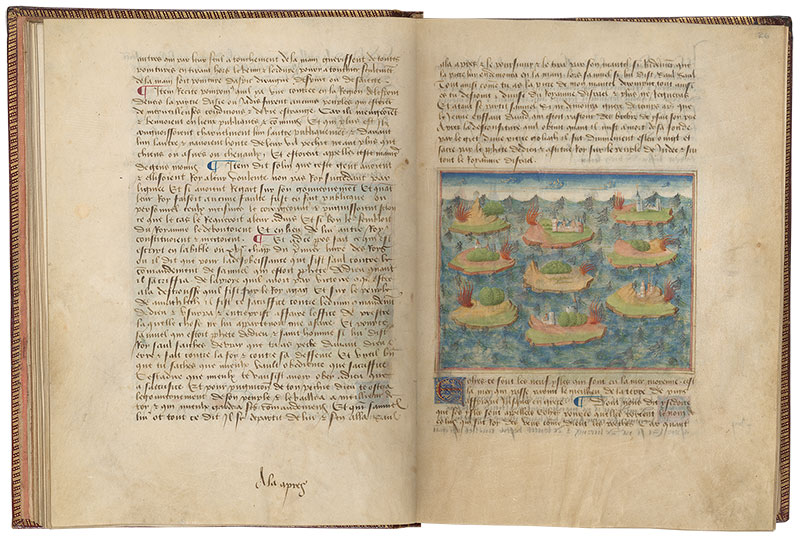
Livre des merveilles du monde
Purchased by J. Pierpont Morgan (1837–1913) in 1911
Nine islands of mountains and trees
These islands are not identified by name or location, but we read that sailors navigate them by the winds that blow consistently across them.
MS M.461, fols. 26v–27r
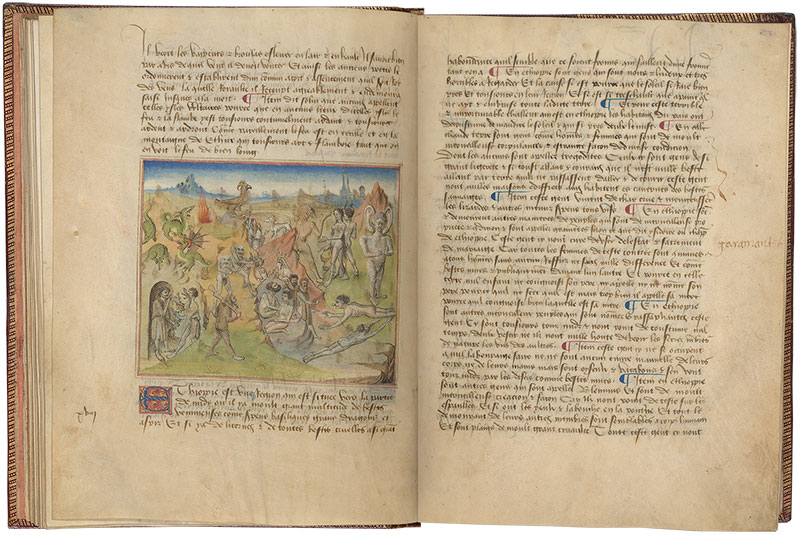
Livre des merveilles du monde
Purchased by J. Pierpont Morgan (1837–1913) in 1911
Ethiopia
Among the more splendid illuminations in the manuscript, the image of Ethiopia presents a cornucopia of monstrous wonders, humanoid and bestial, such as the headless blemmyes, cave-dwelling lizard-eaters, a large-eared giant, and a huge bird of prey with horns.
MS M.461, fols. 27v–28r
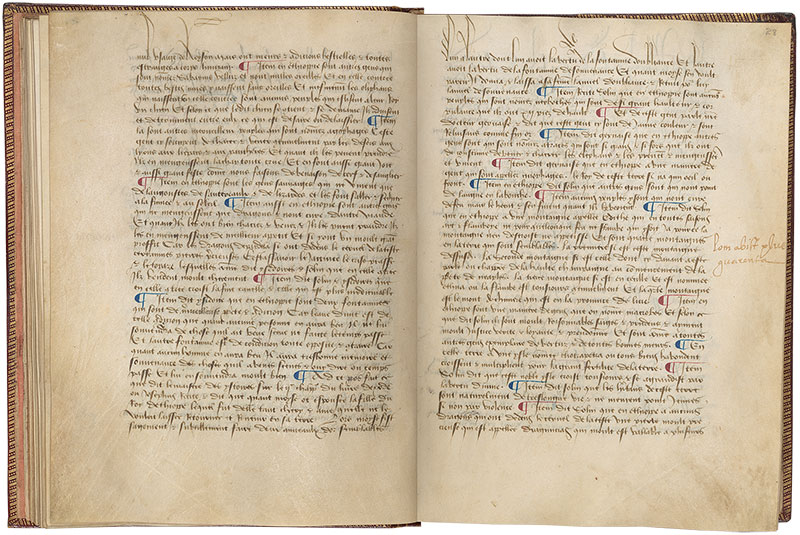
Livre des merveilles du monde
Purchased by J. Pierpont Morgan (1837–1913) in 1911
MS M.461, fols. 28v–29r
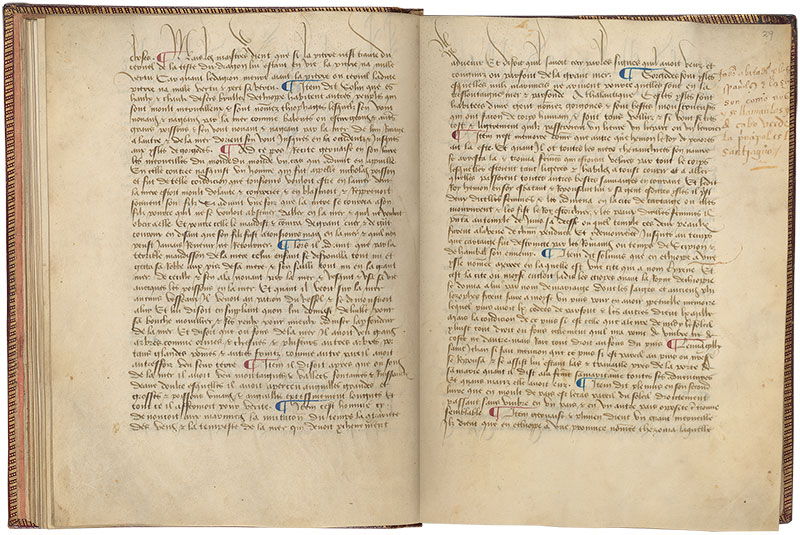
Livre des merveilles du monde
Purchased by J. Pierpont Morgan (1837–1913) in 1911
MS M.461, fols. 29v–30r
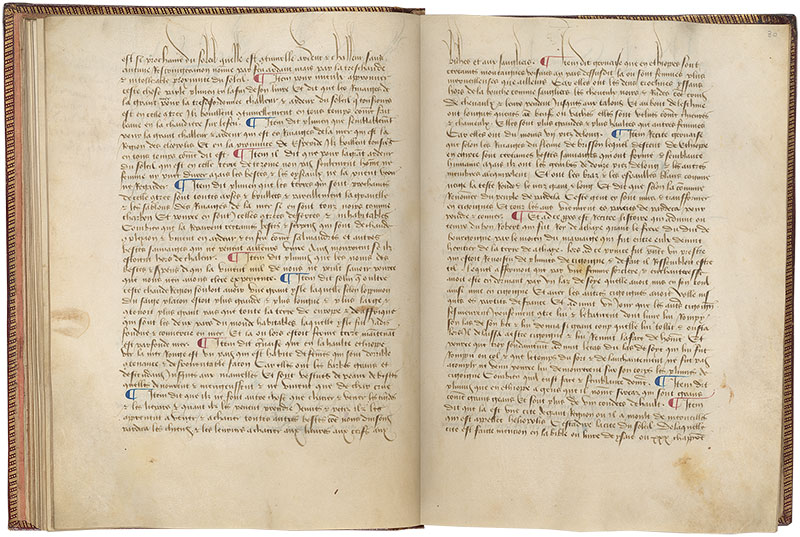
Livre des merveilles du monde
Purchased by J. Pierpont Morgan (1837–1913) in 1911
MS M.461, fols. 30v–31r
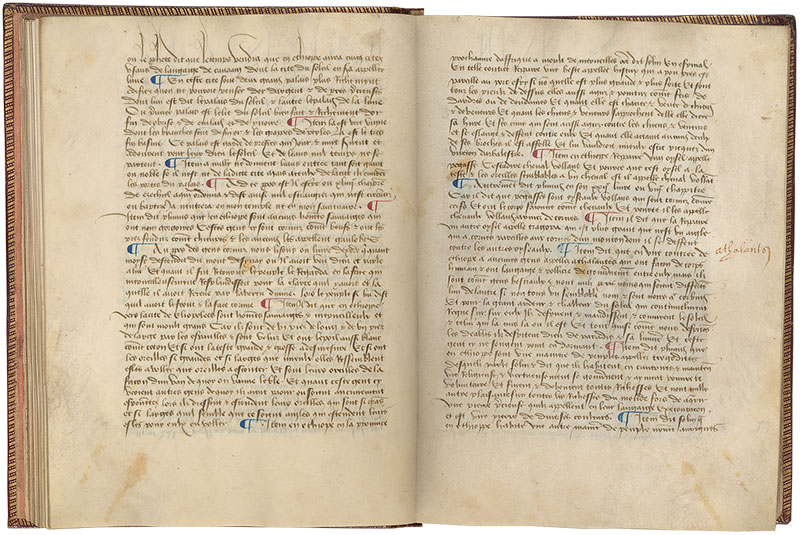
Livre des merveilles du monde
Purchased by J. Pierpont Morgan (1837–1913) in 1911
MS M.461, fols. 31v–32r
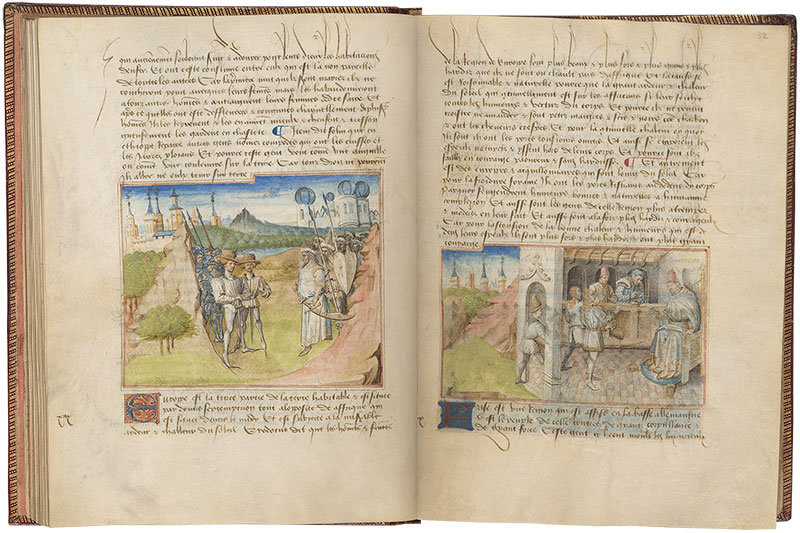
Livre des merveilles du monde
Purchased by J. Pierpont Morgan (1837–1913) in 1911
Europe (left)
This explicitly comparative image sums up the ideological position of the manuscript, with European and African rulers meeting, their armies arrayed behind them; the text takes a strongly prejudiced position, claiming that the men of Europe are handsomer and stronger than those of Africa.
Frisia (right)
Litigants plead their cases before the purportedly incorruptible judges of Frisia.
MS M.461, fols. 32v–33r
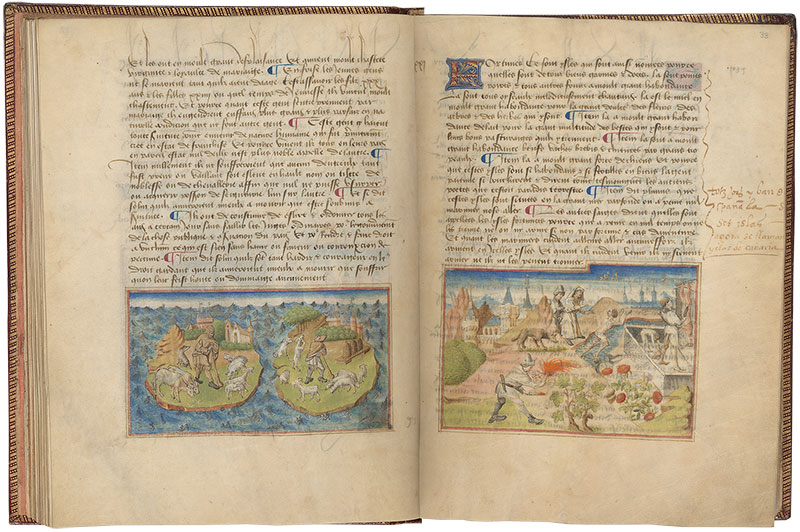
Livre des merveilles du monde
Purchased by J. Pierpont Morgan (1837–1913) in 1911
Canary Islands (left)
The Canary Islands, here called the Fortunate Islands, are shown as rich and abundant in natural resources.
Gaul (right)
While Gaul, where this manuscript was produced, is mostly presented as a land filled with beneficial wonders, the werewolf (appearing as most medieval werewolves do, as fully bestial) is a reminder of the belief in local monsters.
MS M.461, fols. 33v–34r
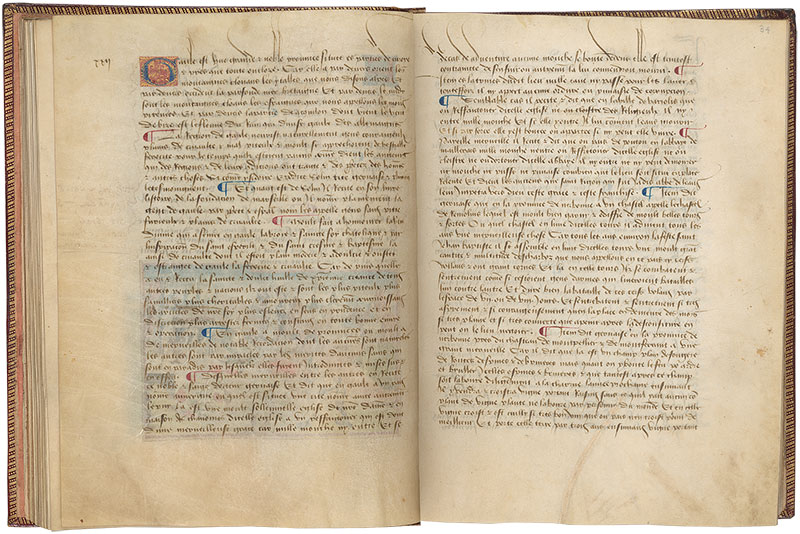
Livre des merveilles du monde
Purchased by J. Pierpont Morgan (1837–1913) in 1911
MS M.461, fols. 34v-35r
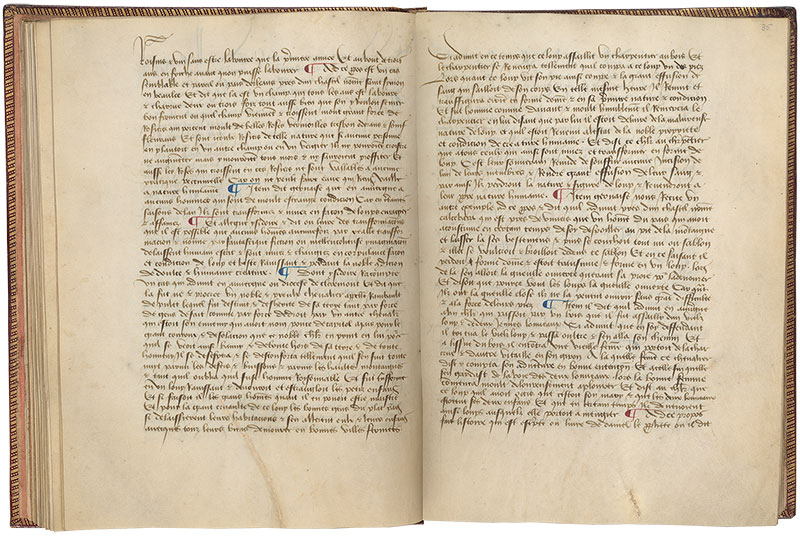
Livre des merveilles du monde
Purchased by J. Pierpont Morgan (1837–1913) in 1911
MS M.461, fols. 35v–36r
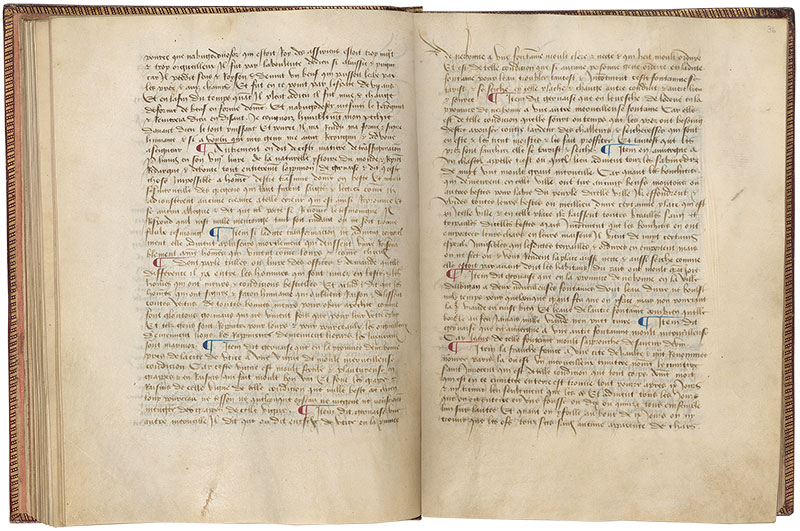
Livre des merveilles du monde
Purchased by J. Pierpont Morgan (1837–1913) in 1911
MS M.461, fols. 36v–37r
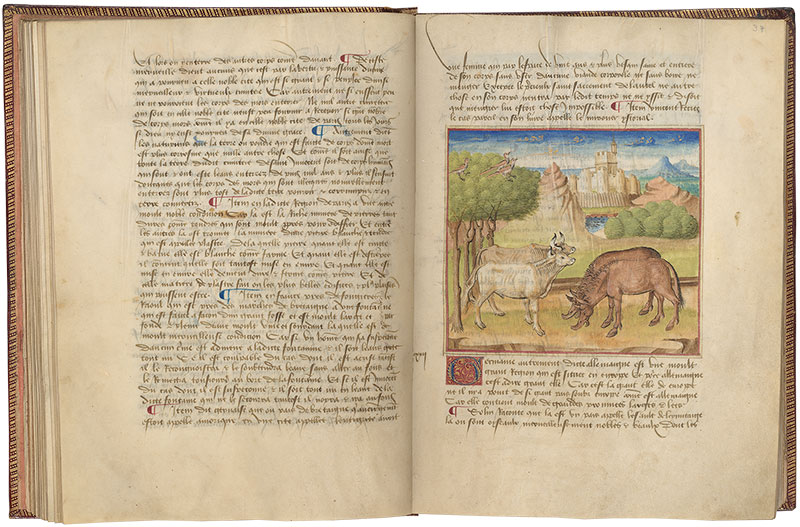
Livre des merveilles du monde
Purchased by J. Pierpont Morgan (1837–1913) in 1911
Germany
Germany is curiously shown without people, just with a few unusual beasts that resemble bulls and mules, though both versions were considered more dangerous than ordinary domestic animals.
MS M.461, fols. 37v–38r
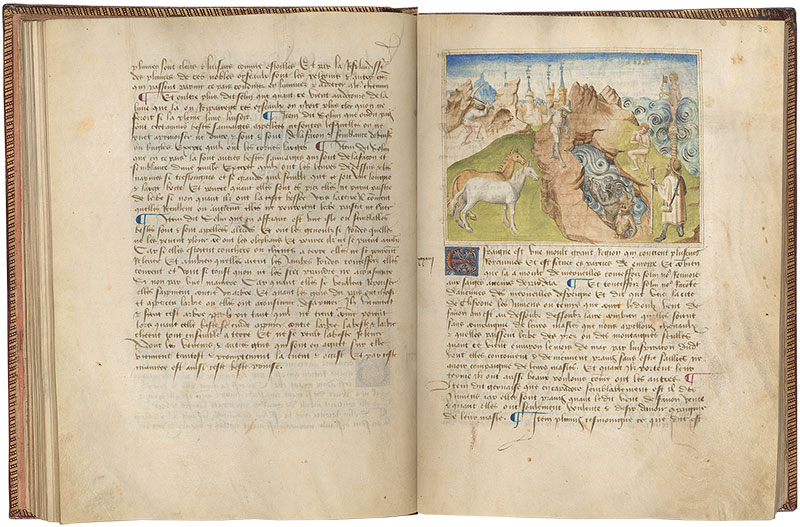
Livre des merveilles du monde
Purchased by J. Pierpont Morgan (1837–1913) in 1911
Spain
Spain contains a lake filled with demons beside an idol purportedly built by Mohammad, echoing a common anti-Islamic myth.
MS M.461, fols. 38v–39r
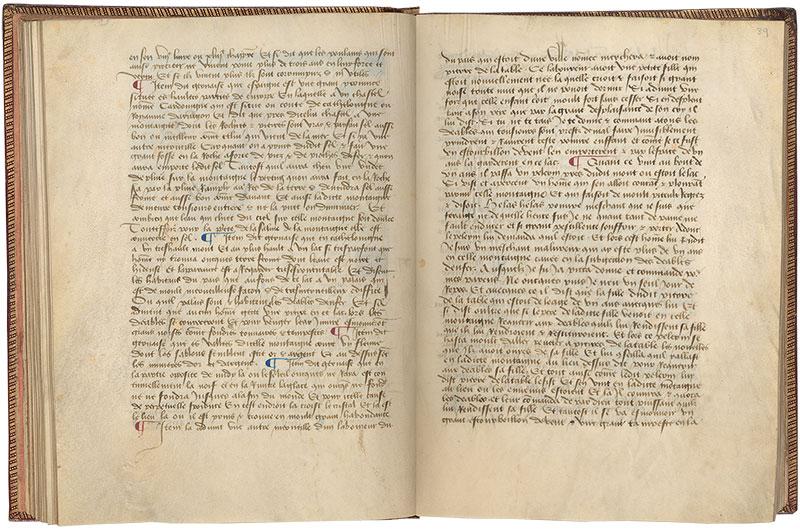
Livre des merveilles du monde
Purchased by J. Pierpont Morgan (1837–1913) in 1911
MS M.461, fols. 39v–40r

Livre des merveilles du monde
Purchased by J. Pierpont Morgan (1837–1913) in 1911
Hibernia
Like other places considered to be at the edge of the world, Ireland is presented as monstrous and wondrous, with warriors who drink the blood of their enemies, but also with St. Patrick leading a sacred procession toward an entrance to purgatory.
MS M.461, fols. 40v–41r
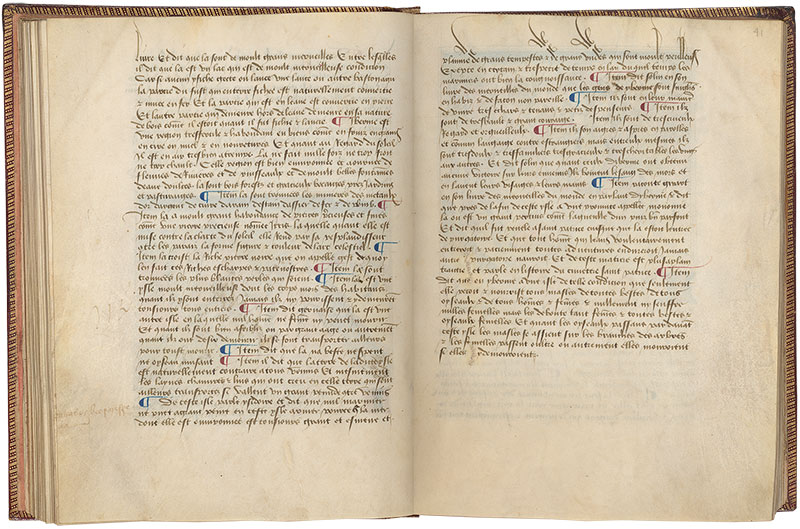
Livre des merveilles du monde
Purchased by J. Pierpont Morgan (1837–1913) in 1911
MS M.461, fols. 41v–42r
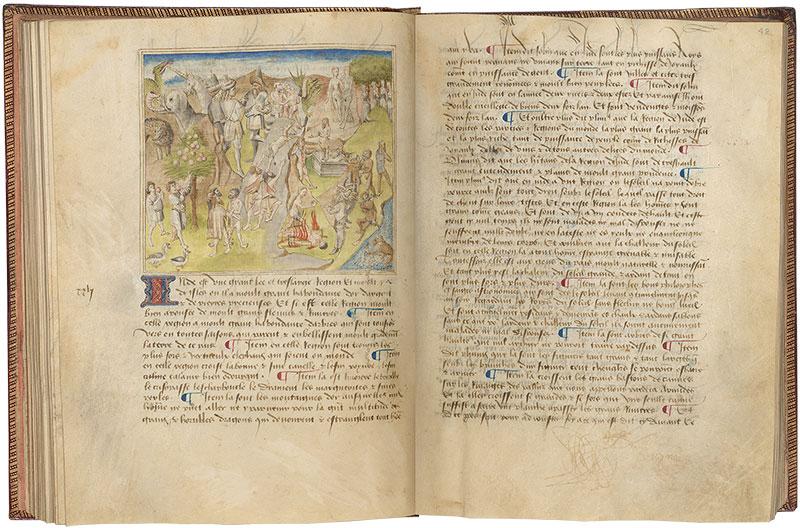
Livre des merveilles du monde
Purchased by J. Pierpont Morgan (1837–1913) in 1911
India
Like Ethiopia, India was highly exoticized in the Middle Ages. Accordingly, this image features a glorious array of monsters and marvels including a dragon, an elephant, a unicorn, dog-headed people called cynocephali, hairy wild men, and people who live on the smell of apples alone.
MS M.461, fols. 42v–43r
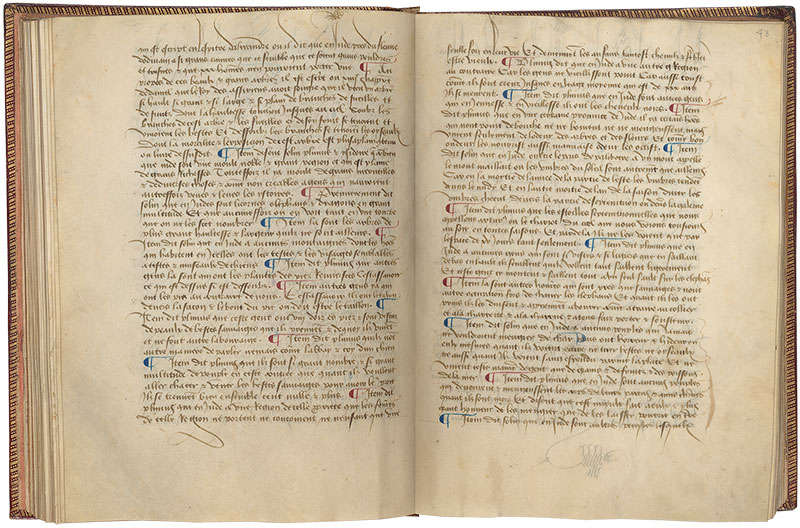
Livre des merveilles du monde
Purchased by J. Pierpont Morgan (1837–1913) in 1911
MS M.461, fols. 43v–44r
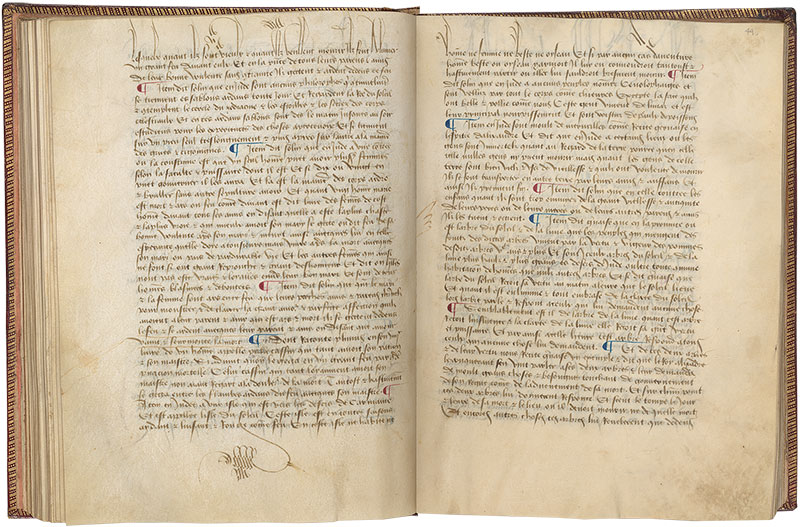
Livre des merveilles du monde
Purchased by J. Pierpont Morgan (1837–1913) in 1911
MS M.461, fols. 44v–45r
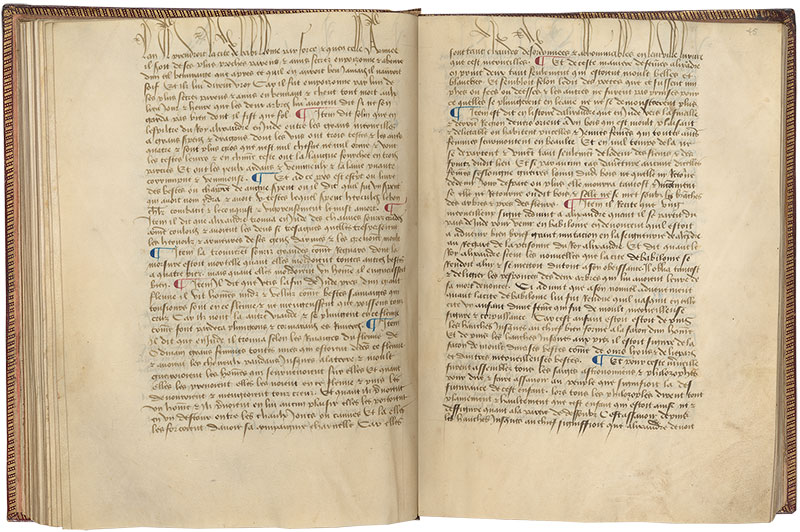
Livre des merveilles du monde
Purchased by J. Pierpont Morgan (1837–1913) in 1911
MS M.461, fols. 45v–46r

Livre des merveilles du monde
Purchased by J. Pierpont Morgan (1837–1913) in 1911
MS M.461, fols. 46v–47r
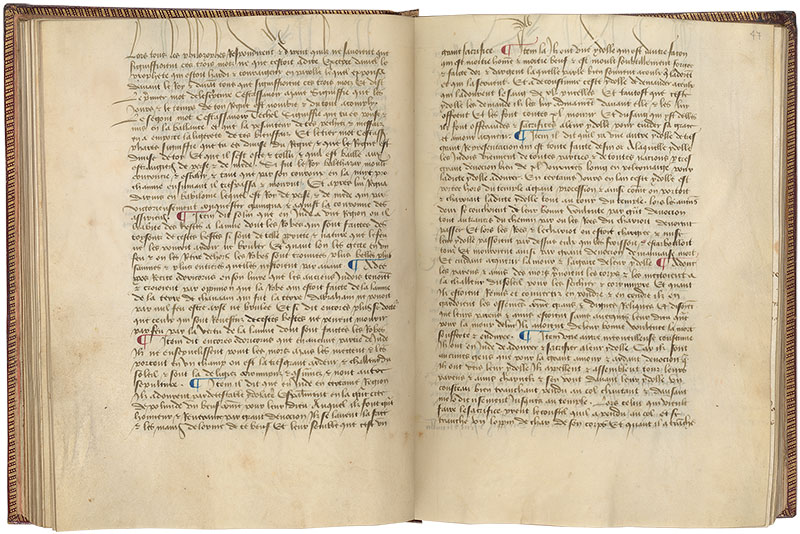
Livre des merveilles du monde
Purchased by J. Pierpont Morgan (1837–1913) in 1911
MS M.461, fols. 47v–48r
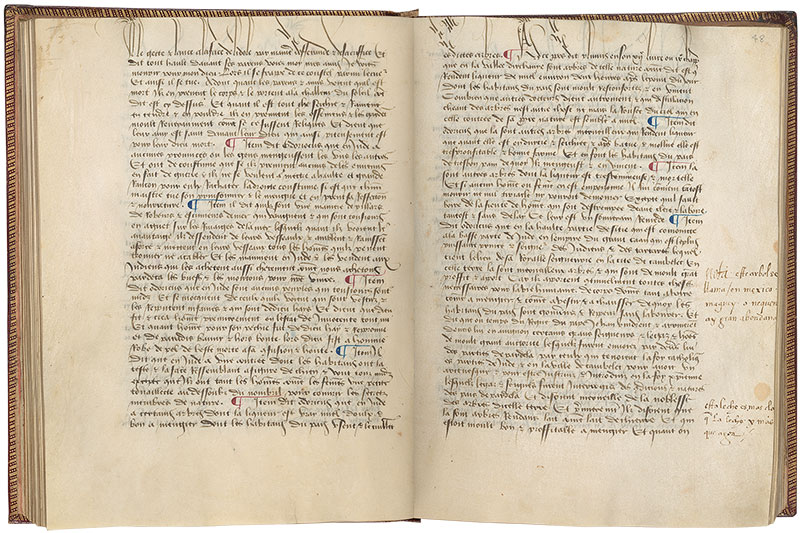
Livre des merveilles du monde
Purchased by J. Pierpont Morgan (1837–1913) in 1911
MS M.461, fols. 48v–49r
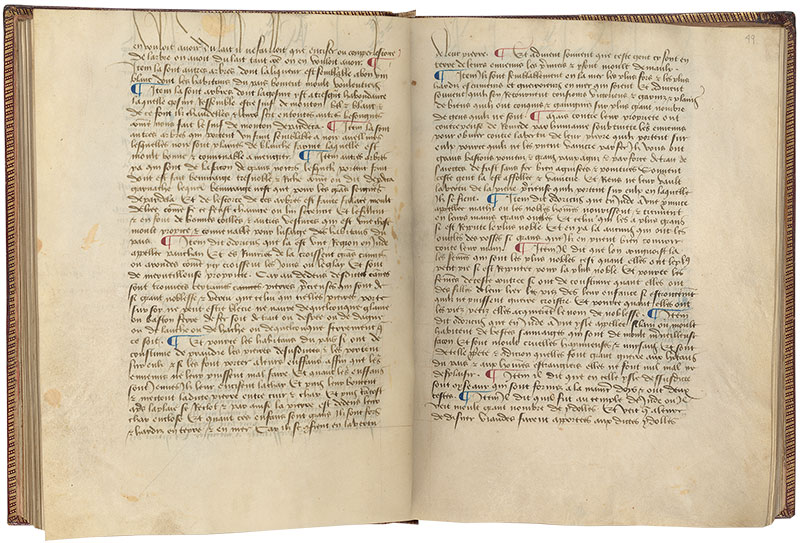
Livre des merveilles du monde
Purchased by J. Pierpont Morgan (1837–1913) in 1911
MS M.461, fols. 49v–50r
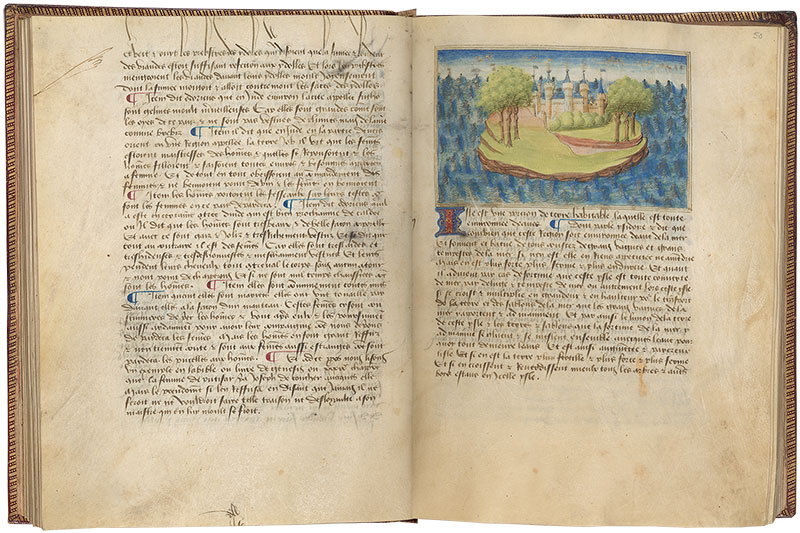
Livre des merveilles du monde
Purchased by J. Pierpont Morgan (1837–1913) in 1911
Island
A generic depiction of an island.
MS M.461, fols. 50v–51r
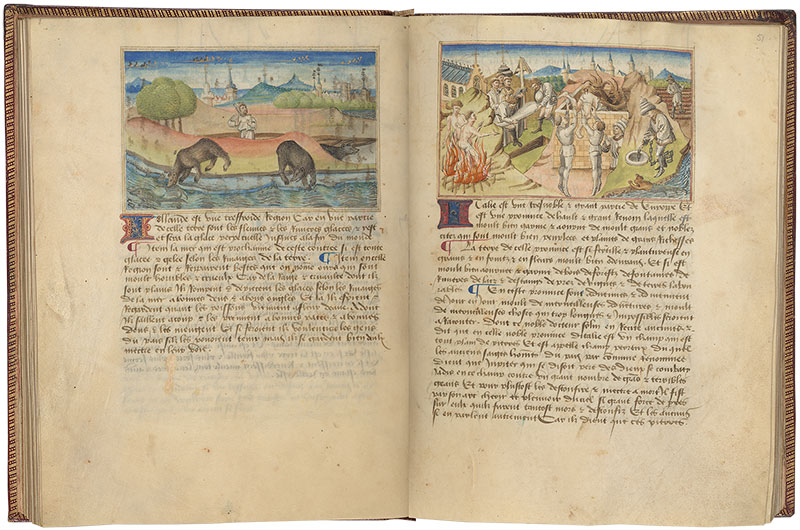
Livre des merveilles du monde
Purchased by J. Pierpont Morgan (1837–1913) in 1911
Iceland (left)
Iceland is shown as a frozen and forbidding land with great bears breaking through the ice for fish.
Italy (right)
For a European country, Italy is shown as quite full of strange wonders, including a pit full of demons being fed a human sacrifice and a merman-like beaver swimming ashore.
MS M.461, fols. 51v–52r
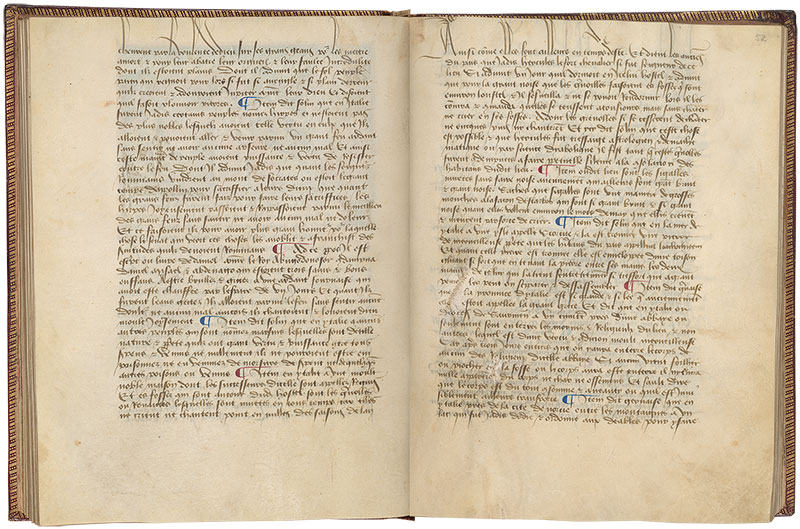
Livre des merveilles du monde
Purchased by J. Pierpont Morgan (1837–1913) in 1911
MS M.461, fols. 52v–53r
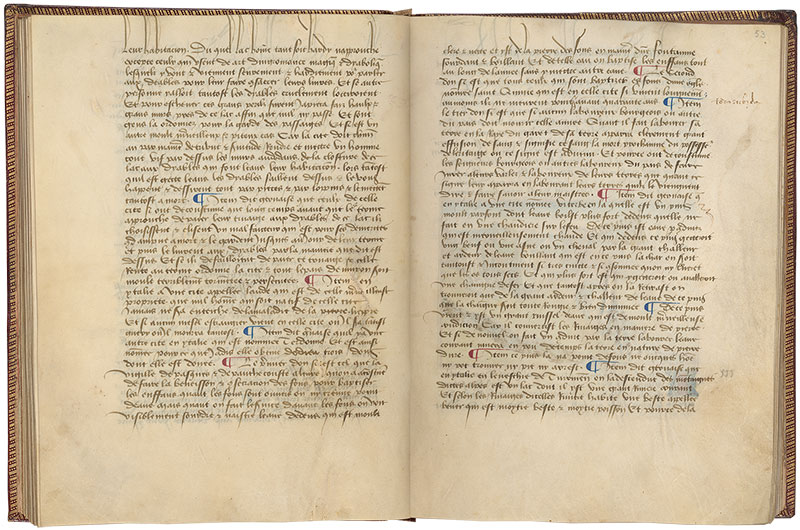
Livre des merveilles du monde
Purchased by J. Pierpont Morgan (1837–1913) in 1911
MS M.461, fols. 53v–54r
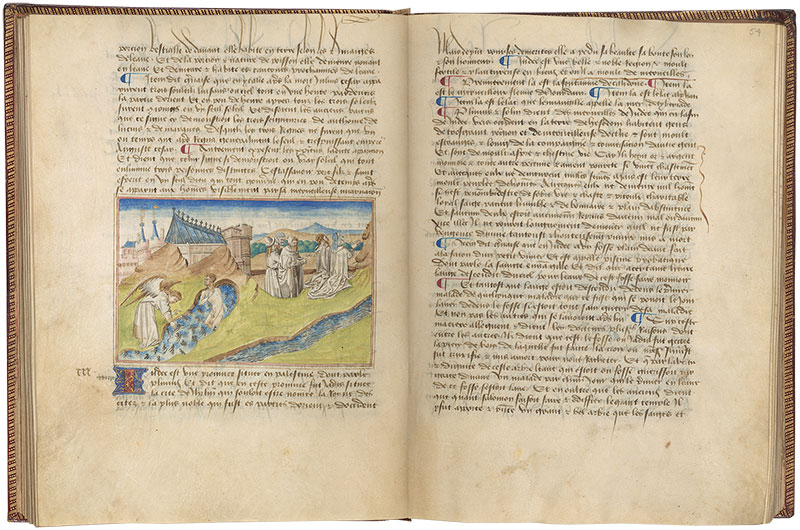
Livre des merveilles du monde
Purchased by J. Pierpont Morgan (1837–1913) in 1911
Judea
Jerusalem is represented here as a Christian territory, with no trace of Jewish or Muslim presence. The miniature features the river Jordan, a group of pious hermits, and the pool of Bethesda stirred by an angel from heaven.
MS M.461, fols. 54v–55r
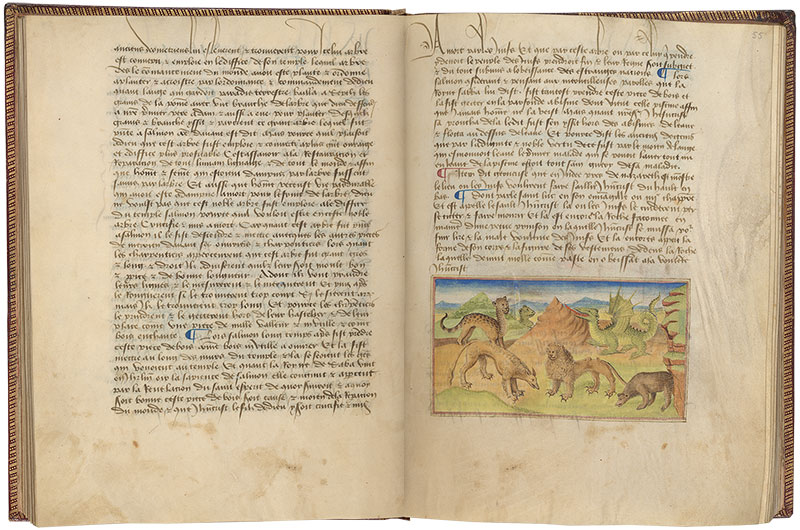
Livre des merveilles du monde
Purchased by J. Pierpont Morgan (1837–1913) in 1911
Libya
Six great beasts inhabit the territory of Libya, clustered in a manner than erodes the distinction between “real” creatures like lions and “imaginary” creatures like dragons.
MS M.461, fols. 55v–56r
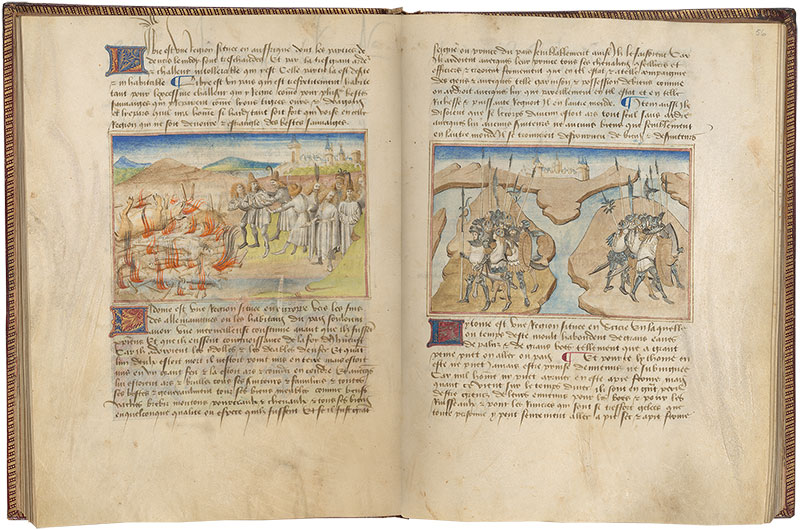
Livre des merveilles du monde
Purchased by J. Pierpont Morgan (1837–1913) in 1911
Livonia (left)
This illumination presents the non-Christian inhabitants of Livonia as savages who burn alive the relatives and friends of prominent men who have died.
Latvia (right)
This land is shown as so swampy and treacherous that armies cannot fight there, as indicated by the two forces heading in opposite directions.
MS M.461, fols. 56v–57r
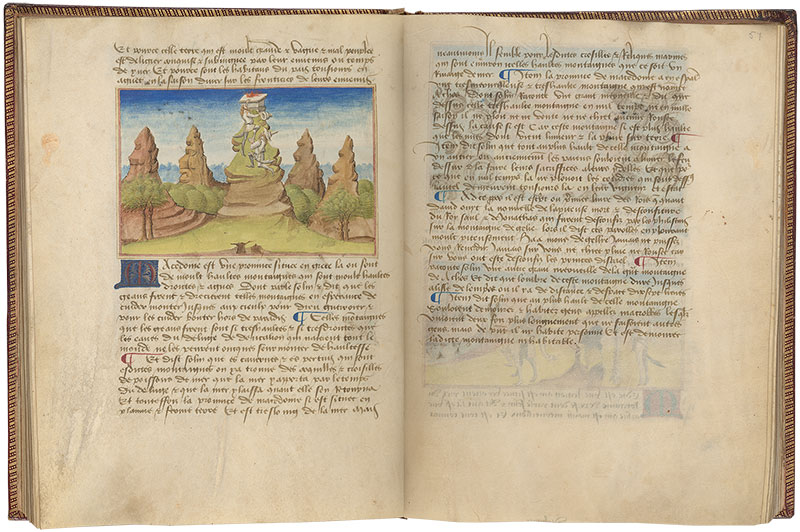
Livre des merveilles du monde
Purchased by J. Pierpont Morgan (1837–1913) in 1911
Macedonia
In the mountainous land of Macedonia, polytheists light a sacrificial fire atop an altar.
MS M.461, fols. 57v–58r
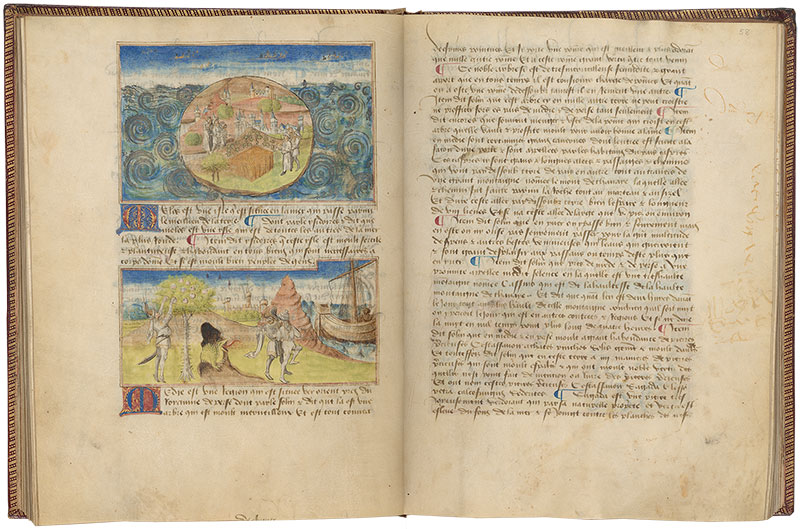
Livre des merveilles du monde
Purchased by J. Pierpont Morgan (1837–1913) in 1911
Melos and Medie
Melos, above, was thought to be a perfectly round island; Medie, below, has apples that can cure poison, but also dangerous serpents and stones that attempt to sink ships.
MS M.461, fols. 58v–59r
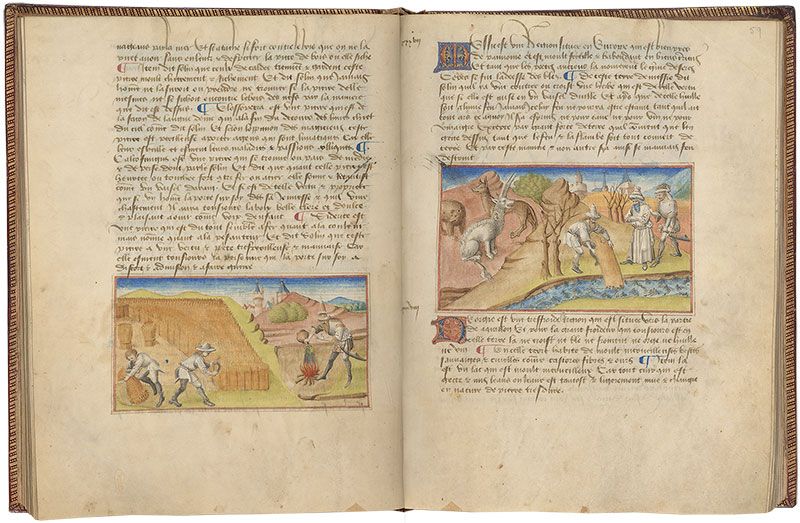
Livre des merveilles du monde
Purchased by J. Pierpont Morgan (1837–1913) in 1911
Moesia (left)
This is a fertile land with a vast field of grain, and a fire that cannot be extinguished unless earth is poured on it.
Norway (right)
In this manuscript the turbaned Norwegians resemble the inhabitants of Arabia and Africa, and the monsters are similarly somewhat interchangeable.
MS M.461, fols. 59v–60r
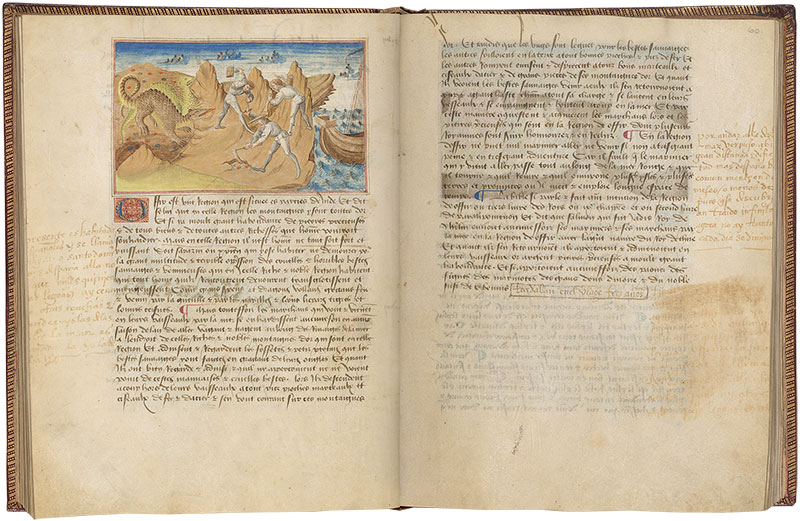
Livre des merveilles du monde
Purchased by J. Pierpont Morgan (1837–1913) in 1911
Ophir
As with many other locations in this manuscript, riches and dangers appear side by side. Here, a dragon menaces three industrious miners.
MS M.461, fols. 60v–61r
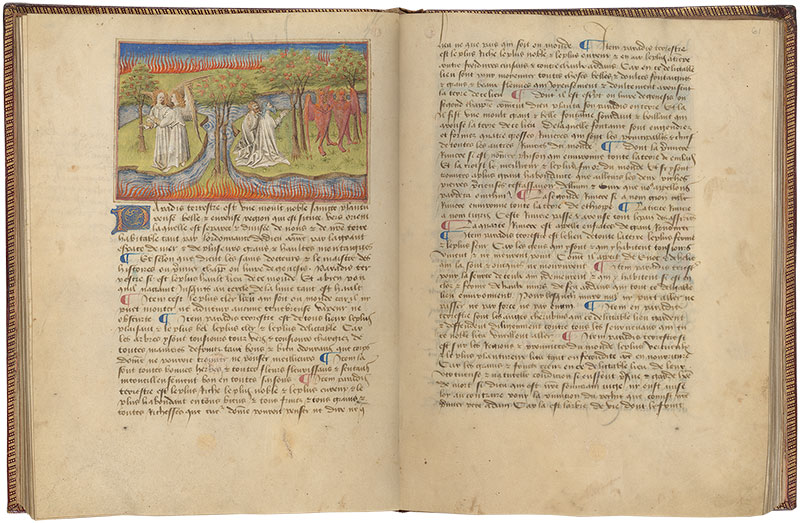
Livre des merveilles du monde
Purchased by J. Pierpont Morgan (1837–1913) in 1911
Earthly Paradise
Medieval theologians argued that Paradise, the Garden of Eden, was a physical place on earth, guarded by an impenetrable fiery wall and fearsome cherubim.
MS M.461, fols. 61v–62r
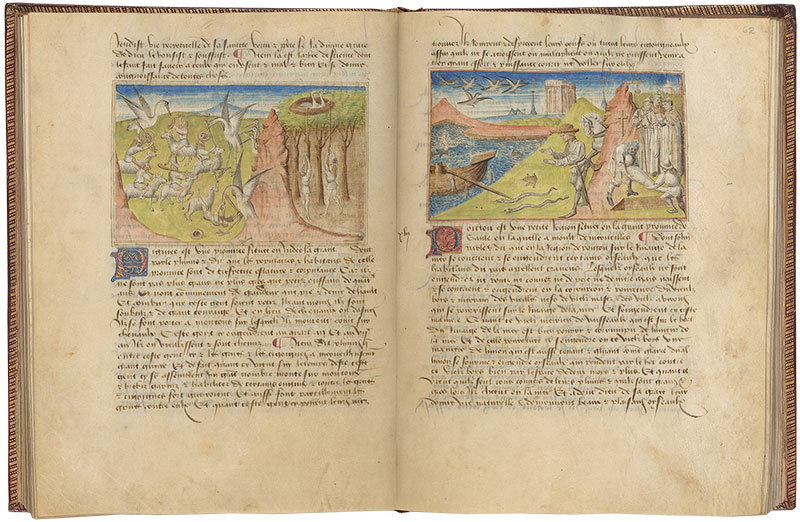
Livre des merveilles du monde
Purchased by J. Pierpont Morgan (1837–1913) in 1911
Pygmy (left)
The diminutive pygmies thought to reside in India are shown here; as is typical of medieval images of them, they are battling with their alleged eternal enemies, the cranes.
Poitou (right)
Poitou has mermaids in the sea, cranes born from driftwood, numerous vermin, and Mont-St-Michel rising over the horizon.
MS M.461, fols. 62v–63r
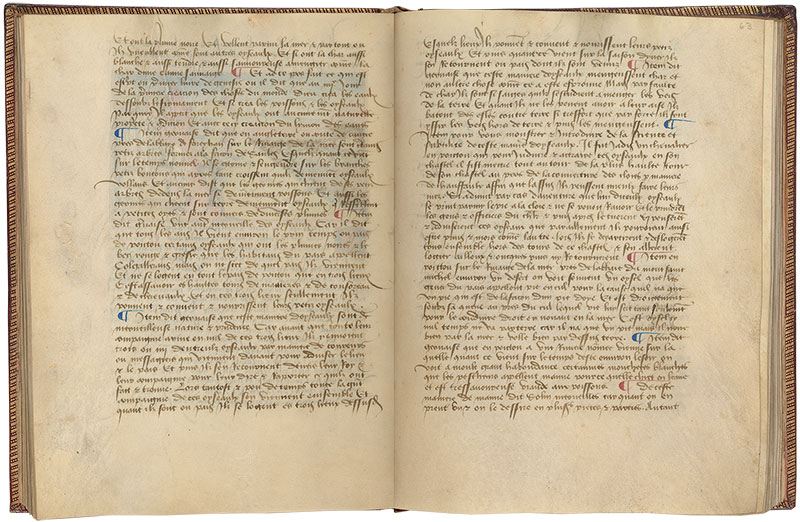
Livre des merveilles du monde
Purchased by J. Pierpont Morgan (1837–1913) in 1911
MS M.461, fols. 63v–64r
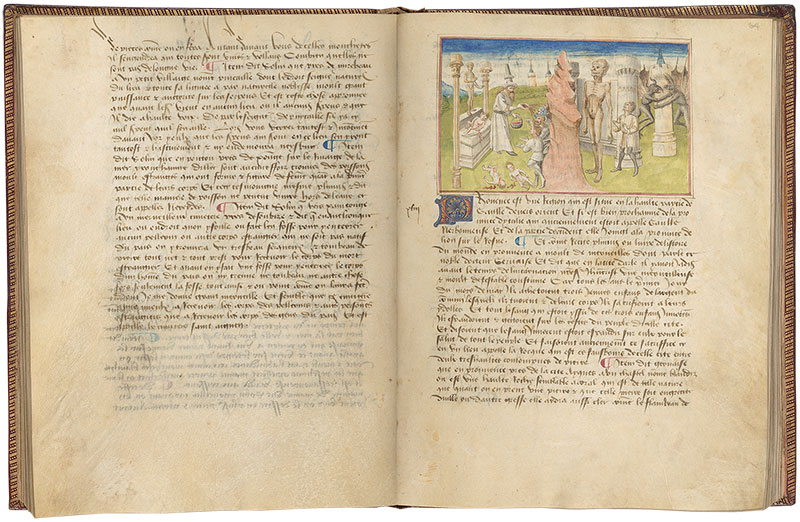
Livre des merveilles du monde
Purchased by J. Pierpont Morgan (1837–1913) in 1911
Provence
Before they became Christians, the inhabitants of Provence sacrificed infants once a year to their idols. They threw the blood of the innocent on their heads. The body of the giant Pallas was found here. There is also a tower brought by devils.
MS M.461, fols. 64v–65r
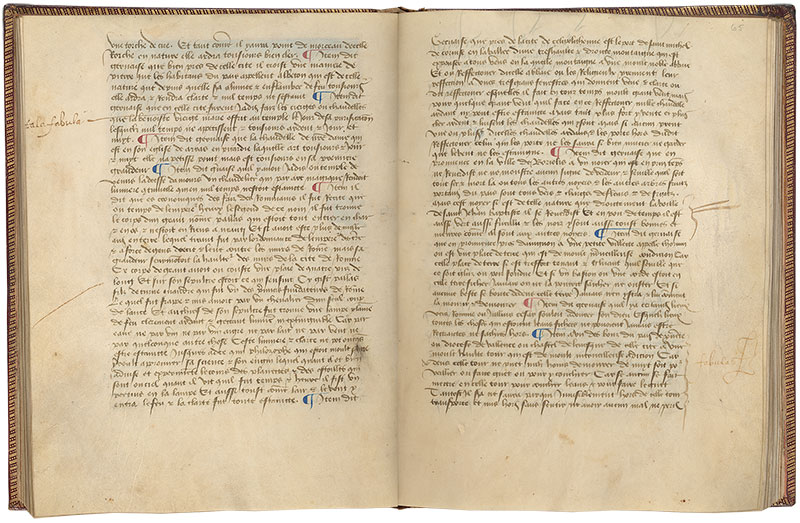
Livre des merveilles du monde
Purchased by J. Pierpont Morgan (1837–1913) in 1911
MS M.461, fols. 65v–66r
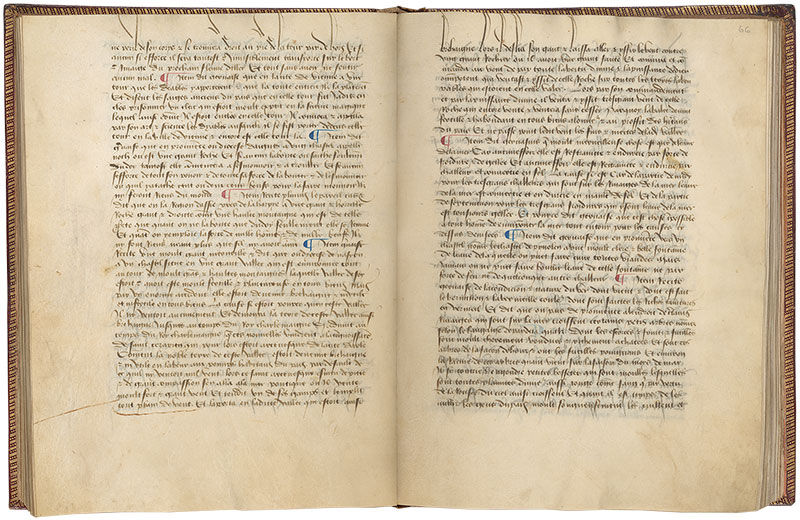
Livre des merveilles du monde
Purchased by J. Pierpont Morgan (1837–1913) in 1911
MS M.461, fols. 66v–67r
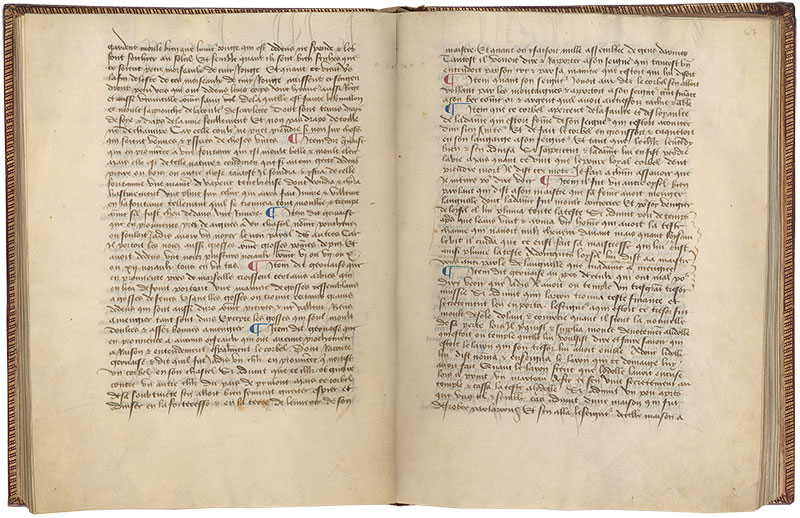
Livre des merveilles du monde
Purchased by J. Pierpont Morgan (1837–1913) in 1911
MS M.461, fols. 67v–68r
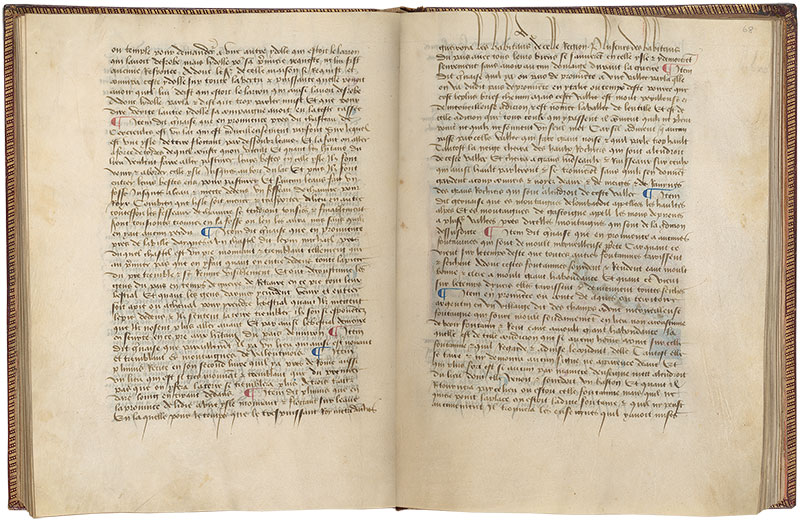
Livre des merveilles du monde
Purchased by J. Pierpont Morgan (1837–1913) in 1911
MS M.461, fols. 68v–69r

Livre des merveilles du monde
Purchased by J. Pierpont Morgan (1837–1913) in 1911
Saba (left)
Saba is shown as a land of fabulous wealth, with gems littering the ground; the phoenix, one of a kind, flies over a miner’s head.
Saxony (right)
A fertile region known for producing fine cattle and sheep. Some of the mountains are home to stag, boar, monkeys and bears.
MS M.461, fols. 69v–70r
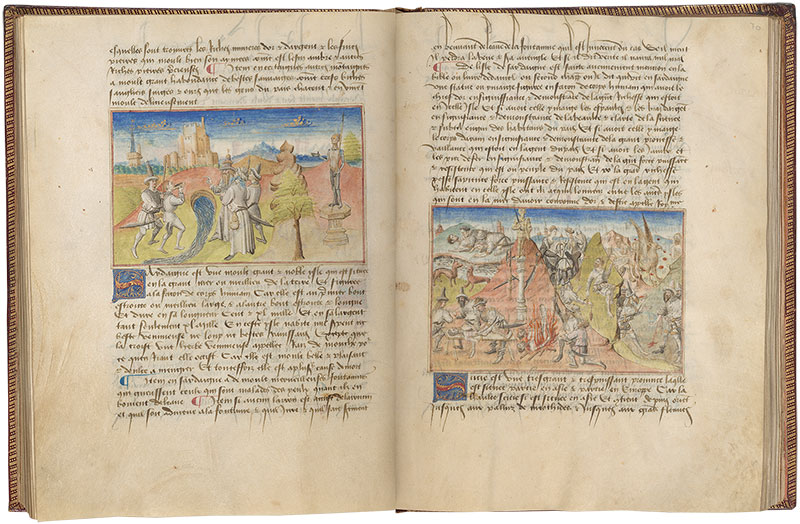
Livre des merveilles du monde
Purchased by J. Pierpont Morgan (1837–1913) in 1911
Sardinia (left)
This image focuses on the curative springs, and an unusual statue made of gold, brass, and iron.
Scythia (right)
This is one of the most spectacular images in the manuscript, with werewolves, cannibals, warrior women, and a griffon.
MS M.461, fols. 70v–71r
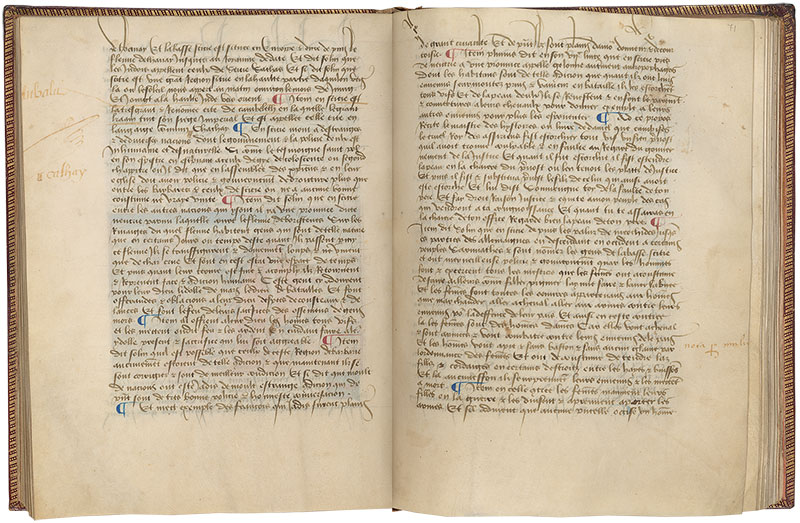
Livre des merveilles du monde
Purchased by J. Pierpont Morgan (1837–1913) in 1911
MS M.461, fols. 71v–72r
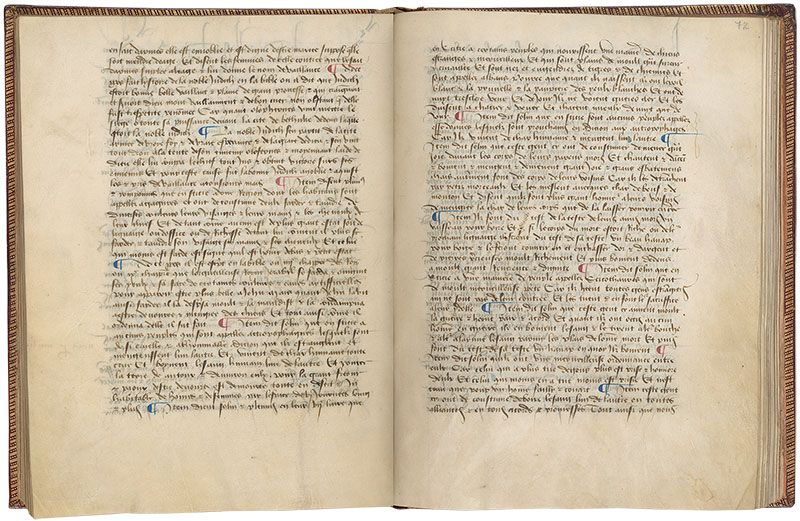
Livre des merveilles du monde
Purchased by J. Pierpont Morgan (1837–1913) in 1911
MS M.461, fols. 72v–73r
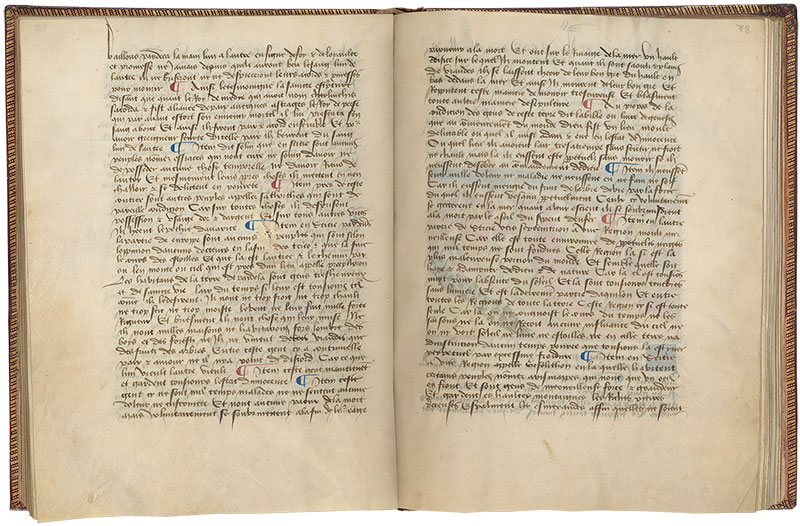
Livre des merveilles du monde
Purchased by J. Pierpont Morgan (1837–1913) in 1911
MS M.461, fols. 73v–74r
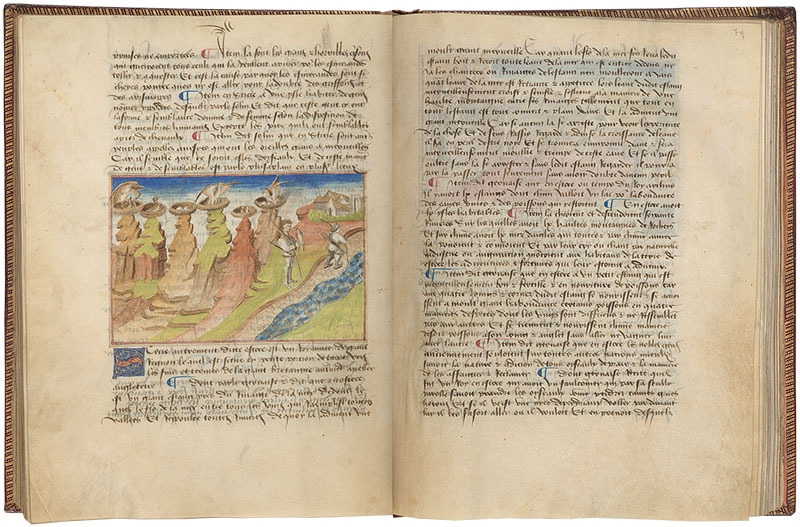
Livre des merveilles du monde
Purchased by J. Pierpont Morgan (1837–1913) in 1911
Scotland
Scotland is shown as a land of dramatic mountains and many birds, including the falcons used by nobles to hunt.
MS M.461, fols. 74v–75r
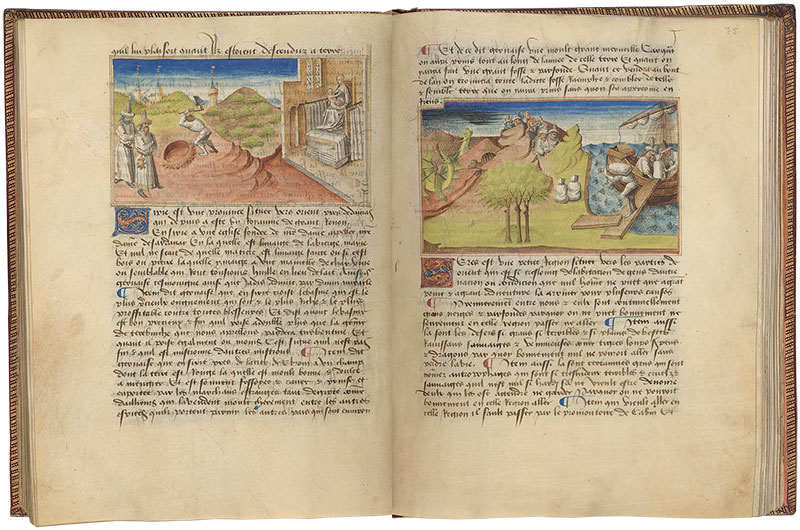
Livre des merveilles du monde
Purchased by J. Pierpont Morgan (1837–1913) in 1911
Syria (left)
Here, the illuminator presents a miraculous image of the Virgin Mary, whose breast lactates oil.
China (right)
China is depicted as not only far away, but inaccessible, divided from Europe by both snow and monsters, and, following a longstanding racist stereotype, the inhabitants of China are characterized as shy and cowardly, hiding behind rocks while European traders leave goods on the beach for them to find later.
MS M.461, fols. 75v–76r
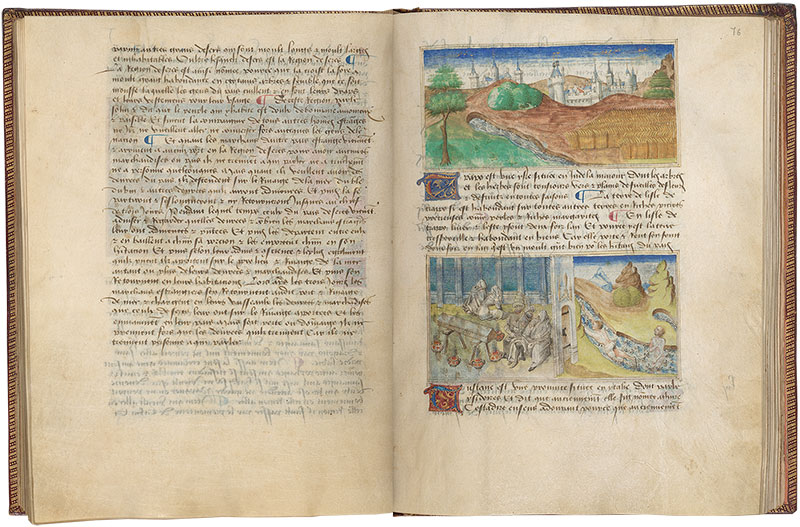
Livre des merveilles du monde
Purchased by J. Pierpont Morgan (1837–1913) in 1911
Sri Lanka and Tuscany
While Sri Lanka, above—known as Taprobane in the Middle Ages—was often presented as a land of dragons, here it is depopulated of people or beasts, simply appearing as a fertile and inviting place. Tuscany, below, is characterized by healthful rivers and elaborate death rites.
MS M.461, fols. 76v–77r
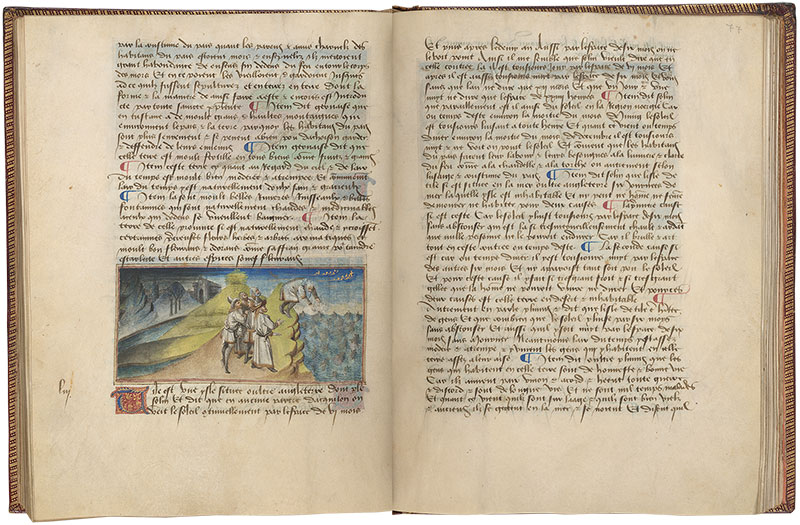
Livre des merveilles du monde
Purchased by J. Pierpont Morgan (1837–1913) in 1911
Thule
Sometimes considered pure myth, sometimes conflated with Iceland, Thule was the farthest western island, here shown as a place where the aged throw themselves into the sea.
MS M.461, fols. 77v–78r
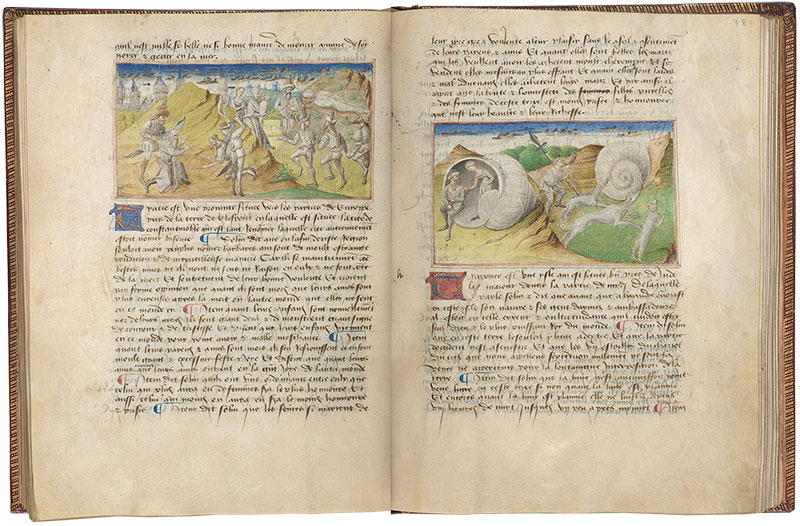
Livre des merveilles du monde
Purchased by J. Pierpont Morgan (1837–1913) in 1911
Thrace (left)
The grand city of Constantinople rises in the background of Thrace, which is depicted as a world turned upside down where the afterlife is seen as so preferable to this world that mothers mourn the birth of children and people are happy to be murdered.
Sri Lanka (right)
A second image of Sri Lanka/Taprobane presents an entertaining scene of giant snails with shells big enough to serve as homes for the humans of the region.
MS M.461, fols. 78v–79r
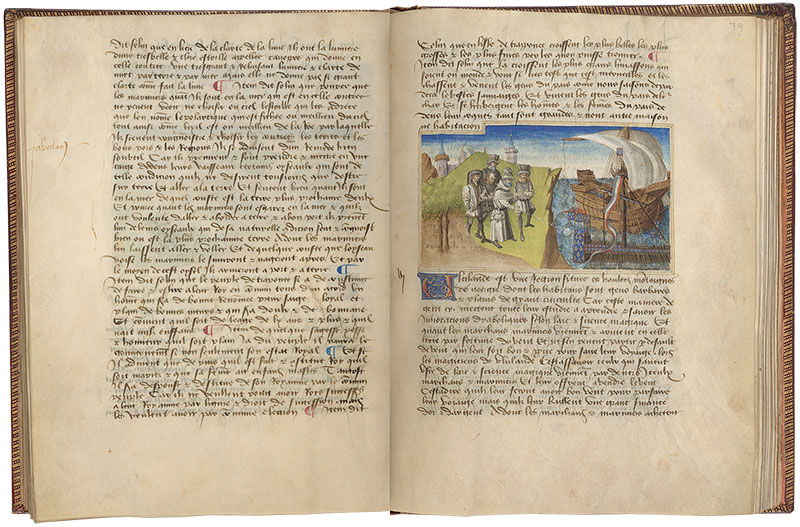
Livre des merveilles du monde
Purchased by J. Pierpont Morgan (1837–1913) in 1911
Ululande
Ululande is the final image in this manuscript, a cold region of Scandinavia where wizards sell the wind to passing sailors.
MS M.461, fols. 79v–80r
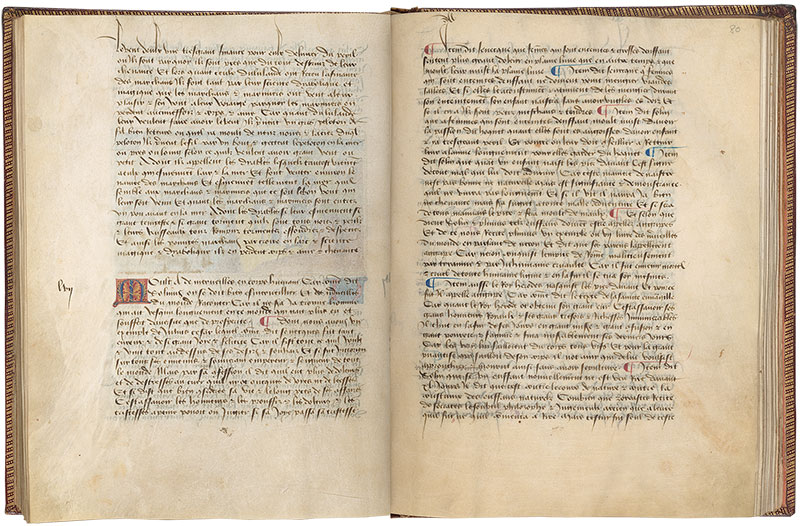
Livre des merveilles du monde
Purchased by J. Pierpont Morgan (1837–1913) in 1911
MS M.461, fols. 80v–81r
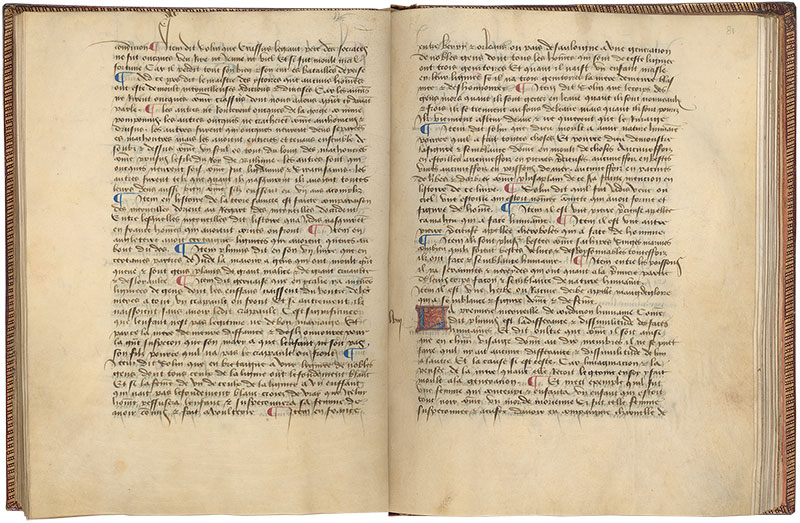
Livre des merveilles du monde
Purchased by J. Pierpont Morgan (1837–1913) in 1911
MS M.461, fols. 81v–82r
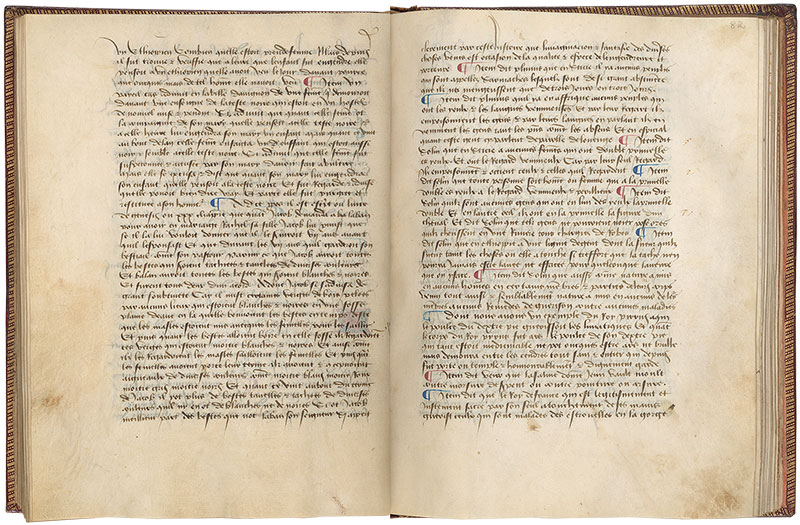
Livre des merveilles du monde
Purchased by J. Pierpont Morgan (1837–1913) in 1911
MS M.461, fols. 82v–83r
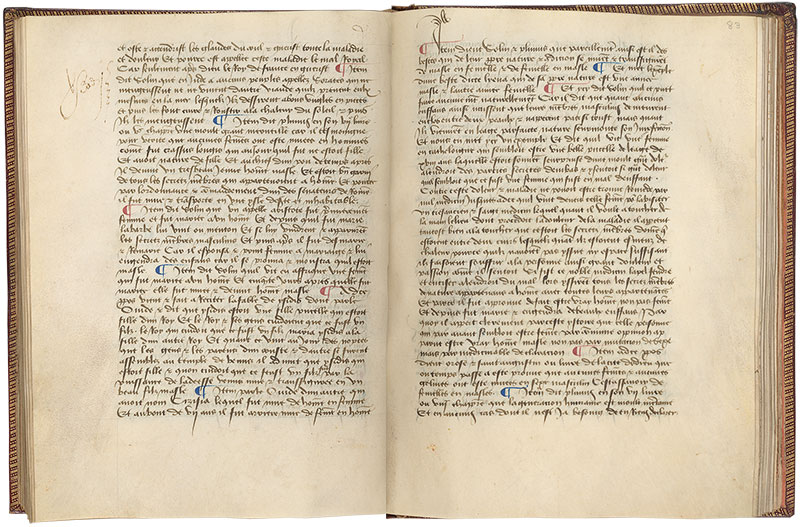
Livre des merveilles du monde
Purchased by J. Pierpont Morgan (1837–1913) in 1911
MS M.461, fols. 83v–84r
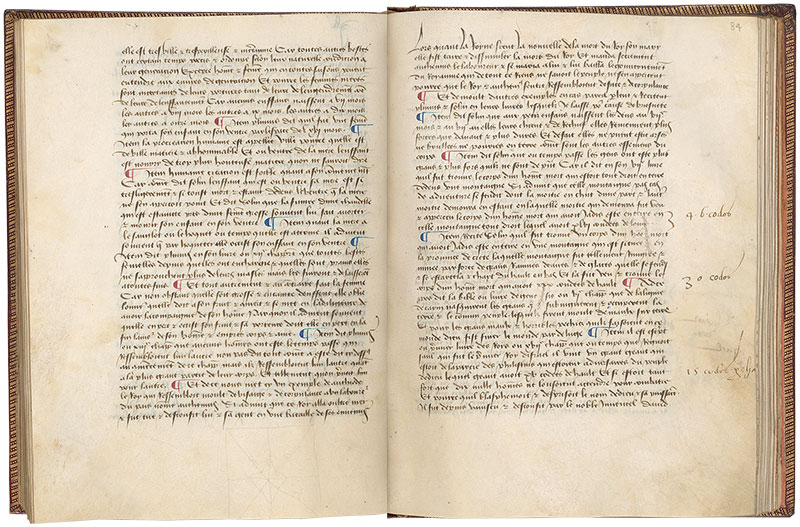
Livre des merveilles du monde
Purchased by J. Pierpont Morgan (1837–1913) in 1911
MS M.461, fols. 84v–85r

Livre des merveilles du monde
Purchased by J. Pierpont Morgan (1837–1913) in 1911
MS M.461, fols. 85v–86r
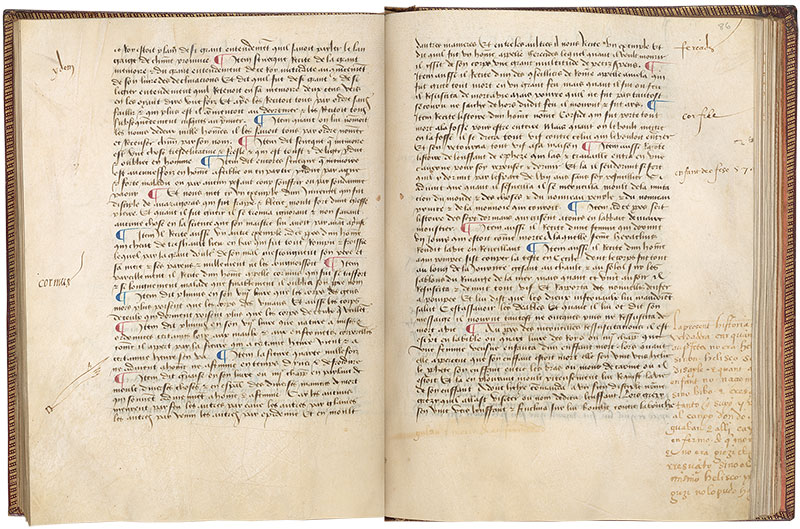
Livre des merveilles du monde
Purchased by J. Pierpont Morgan (1837–1913) in 1911
MS M.461, fols. 86v–87r
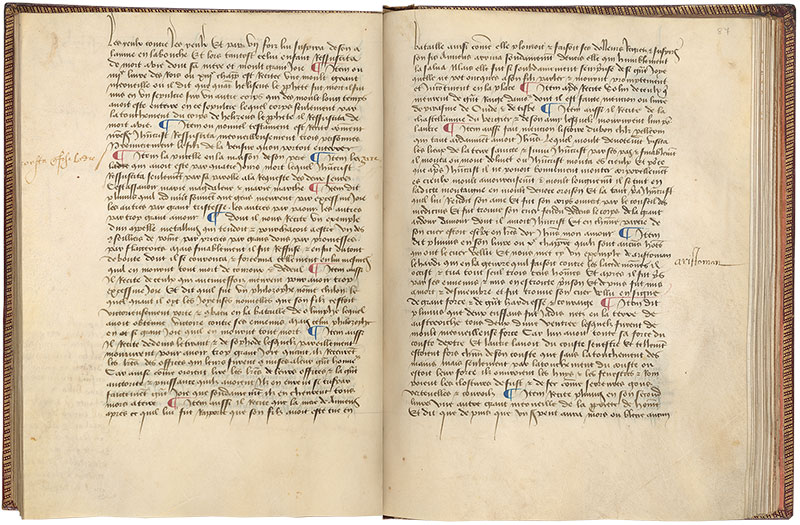
Livre des merveilles du monde
Purchased by J. Pierpont Morgan (1837–1913) in 1911
MS M.461, fols. 87v–88r
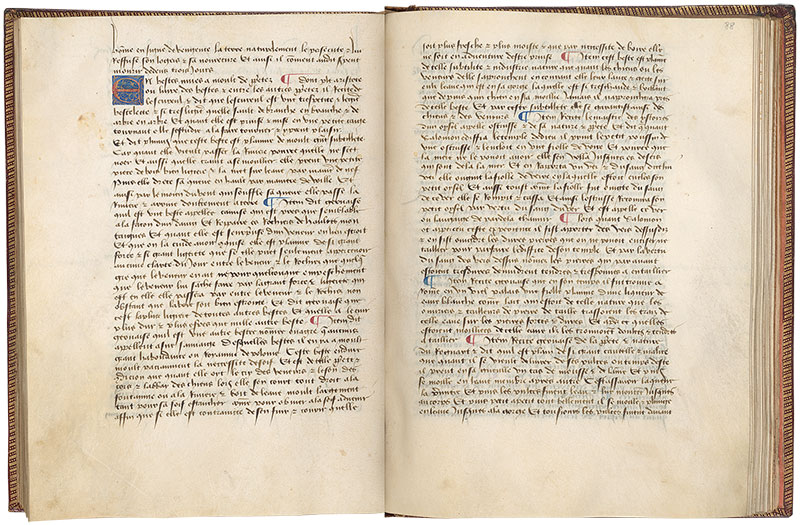
Livre des merveilles du monde
Purchased by J. Pierpont Morgan (1837–1913) in 1911
MS M.461, fols. 88v–89r
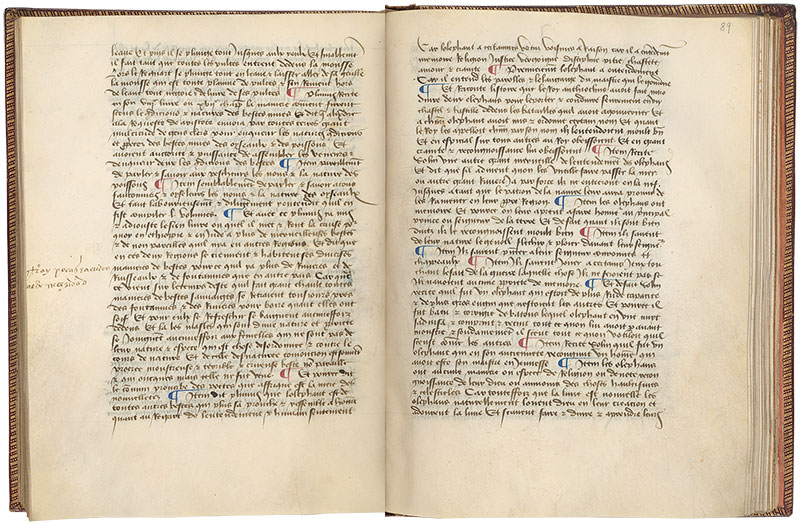
Livre des merveilles du monde
Purchased by J. Pierpont Morgan (1837–1913) in 1911
MS M.461, fols. 89v–90r
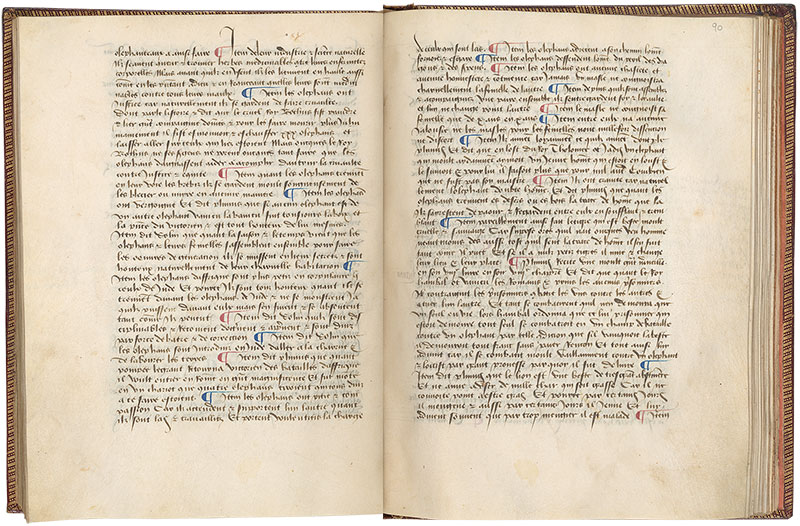
Livre des merveilles du monde
Purchased by J. Pierpont Morgan (1837–1913) in 1911
MS M.461, fols. 90v–91r
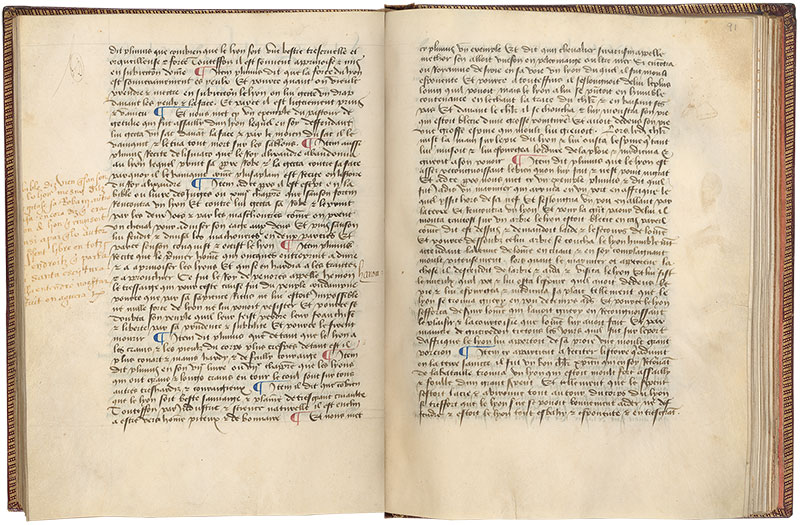
Livre des merveilles du monde
Purchased by J. Pierpont Morgan (1837–1913) in 1911
MS M.461, fols. 91v–92r
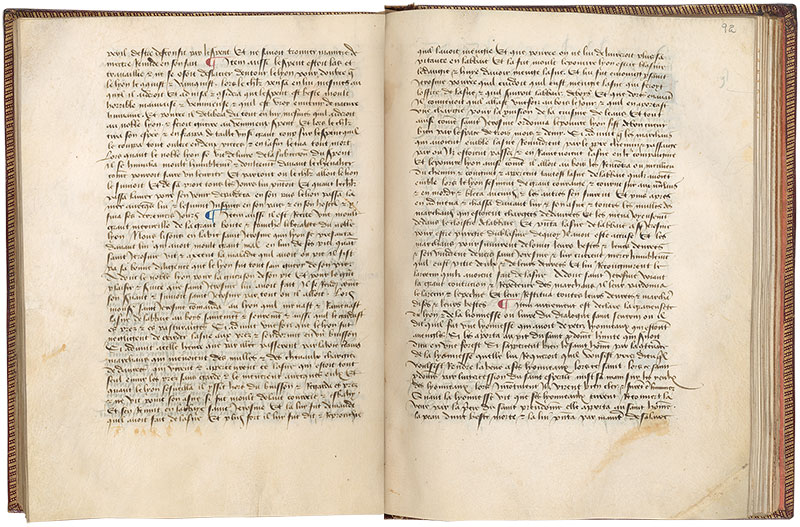
Livre des merveilles du monde
Purchased by J. Pierpont Morgan (1837–1913) in 1911
MS M.461, fols. 92v–93r
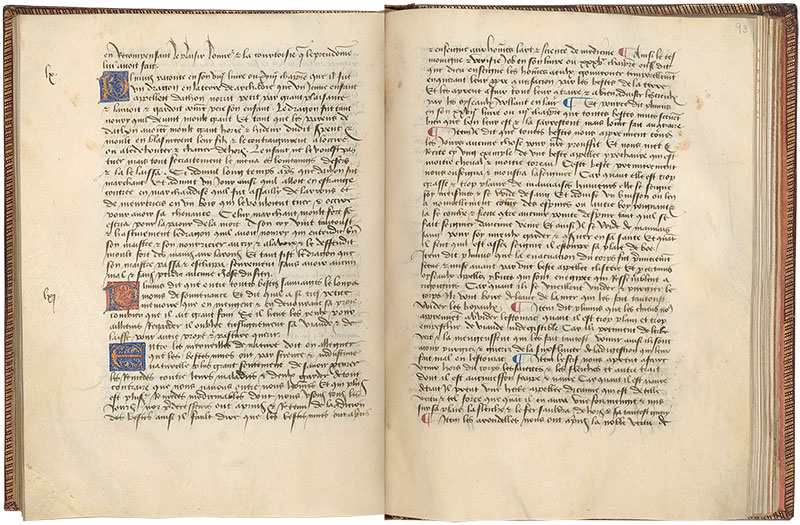
Livre des merveilles du monde
Purchased by J. Pierpont Morgan (1837–1913) in 1911
MS M.461, fols. 93v–94r
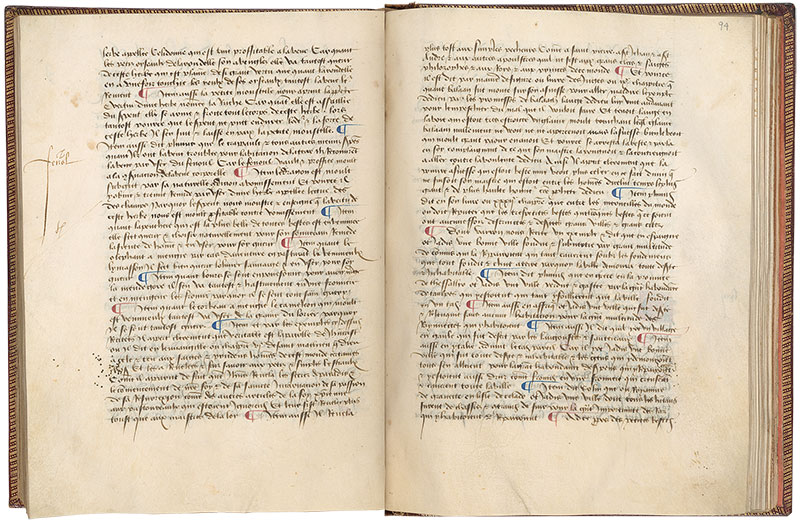
Livre des merveilles du monde
Purchased by J. Pierpont Morgan (1837–1913) in 1911
MS M.461, fols. 94v–95r
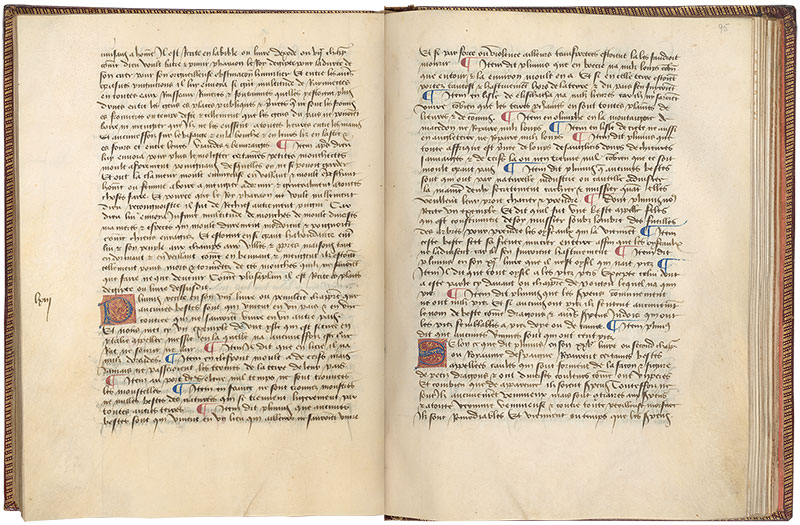
Livre des merveilles du monde
Purchased by J. Pierpont Morgan (1837–1913) in 1911
MS M.461, fols. 95v–96r
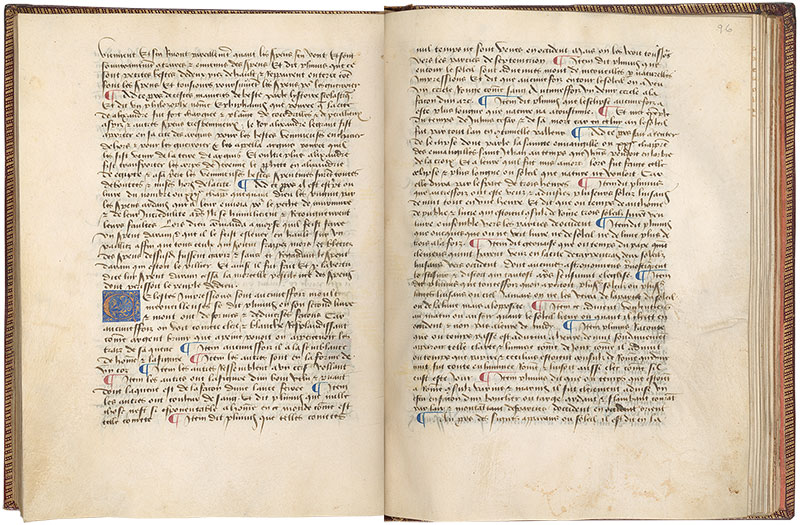
Livre des merveilles du monde
Purchased by J. Pierpont Morgan (1837–1913) in 1911
MS M.461, fols. 96v–97r
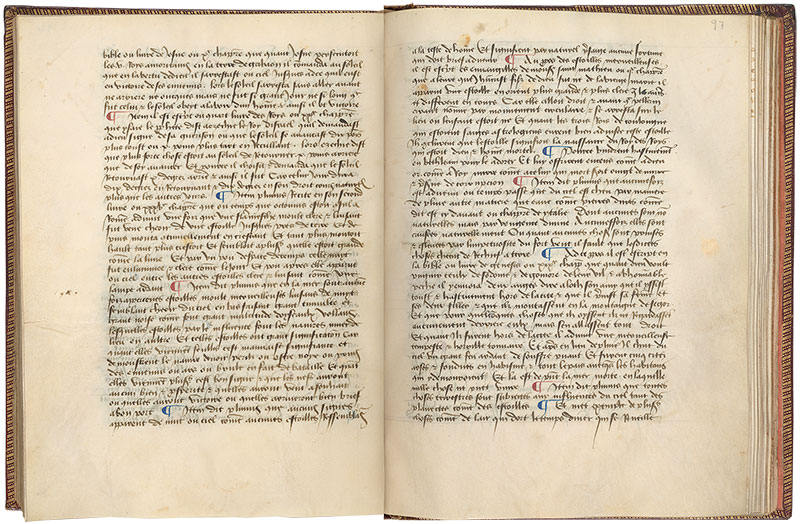
Livre des merveilles du monde
Purchased by J. Pierpont Morgan (1837–1913) in 1911
MS M.461, fols. 97v–98r
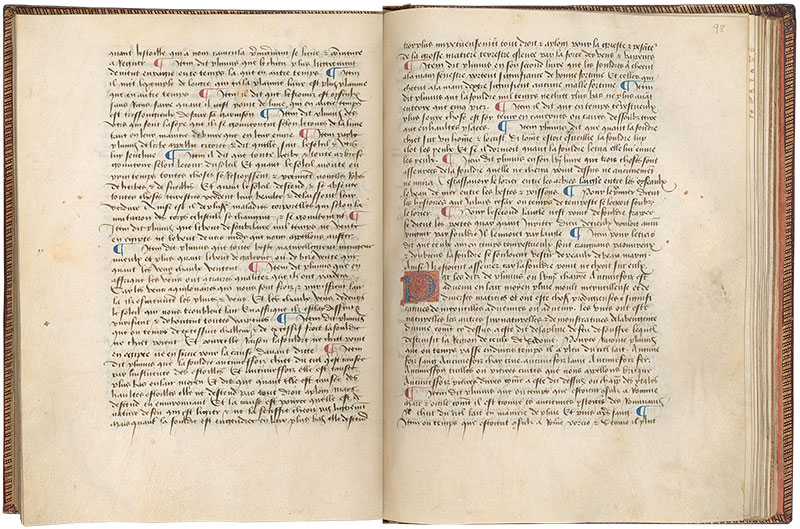
Livre des merveilles du monde
Purchased by J. Pierpont Morgan (1837–1913) in 1911
MS M.461, fols. 98v–99r
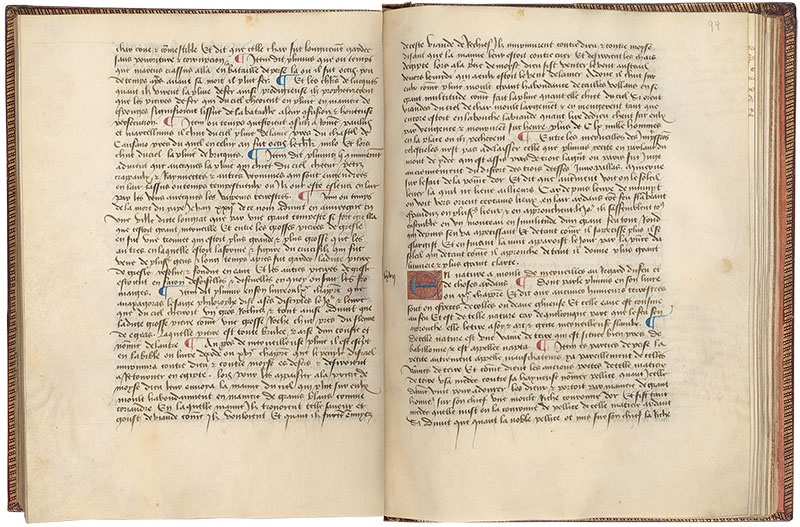
Livre des merveilles du monde
Purchased by J. Pierpont Morgan (1837–1913) in 1911
MS M.461, fols. 99v–100r
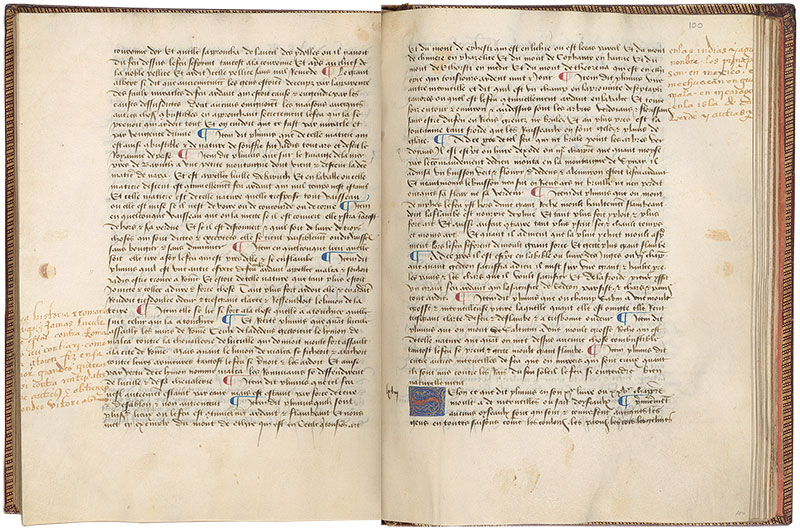
Livre des merveilles du monde
Purchased by J. Pierpont Morgan (1837–1913) in 1911
MS M.461, fols. 100v–101r
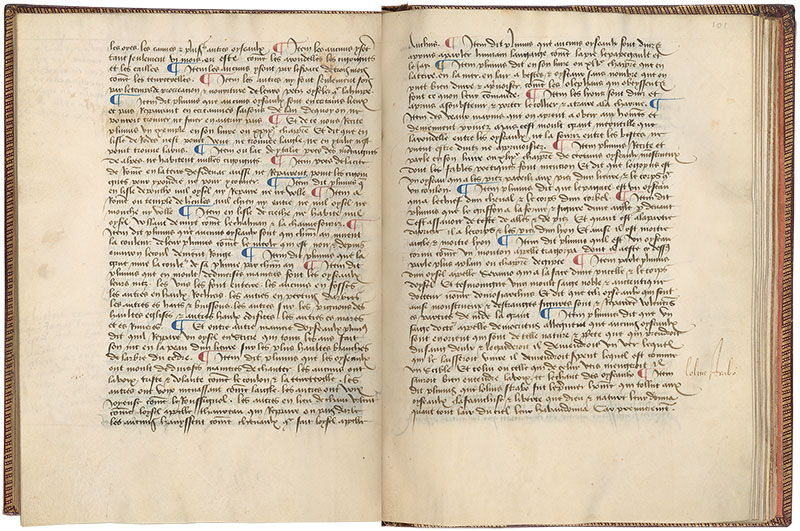
Livre des merveilles du monde
Purchased by J. Pierpont Morgan (1837–1913) in 1911
MS M.461, fols. 101v–102r
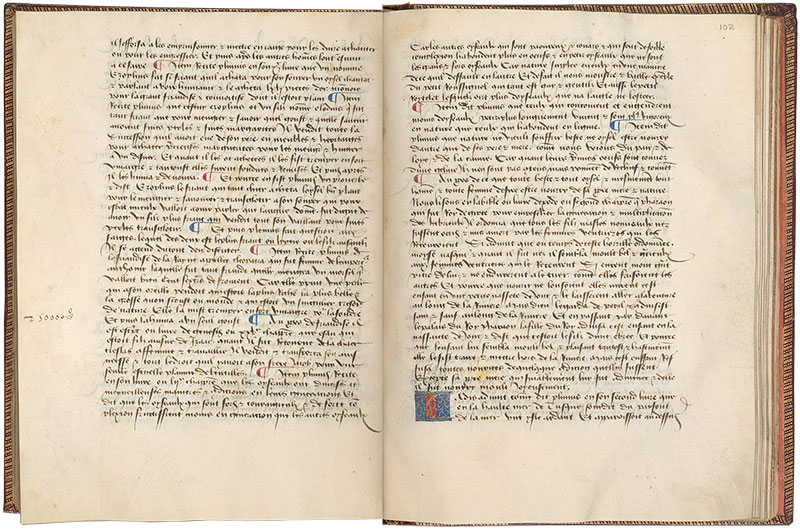
Livre des merveilles du monde
Purchased by J. Pierpont Morgan (1837–1913) in 1911
MS M.461, fols. 102v–103r
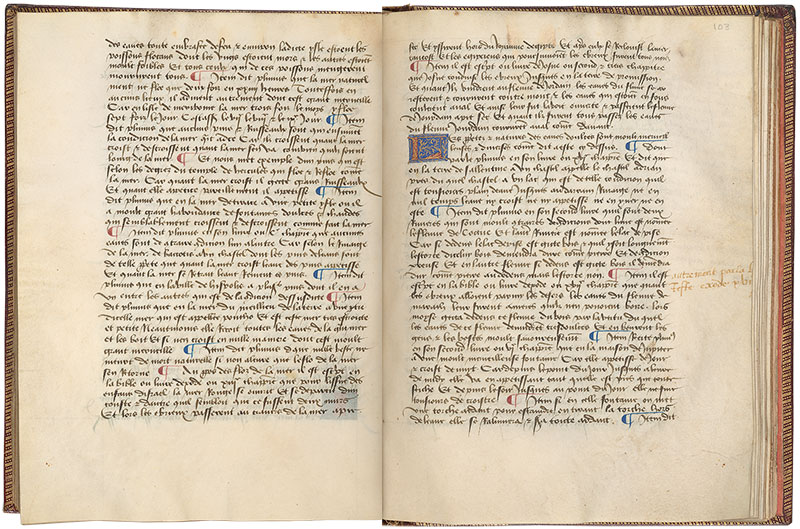
Livre des merveilles du monde
Purchased by J. Pierpont Morgan (1837–1913) in 1911
MS M.461, fols. 103v–104r
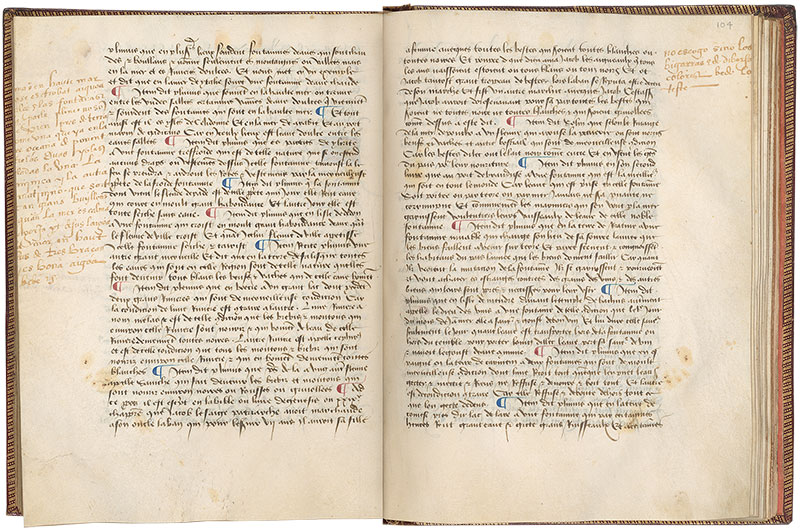
Livre des merveilles du monde
Purchased by J. Pierpont Morgan (1837–1913) in 1911
MS M.461, fols. 104v–105r
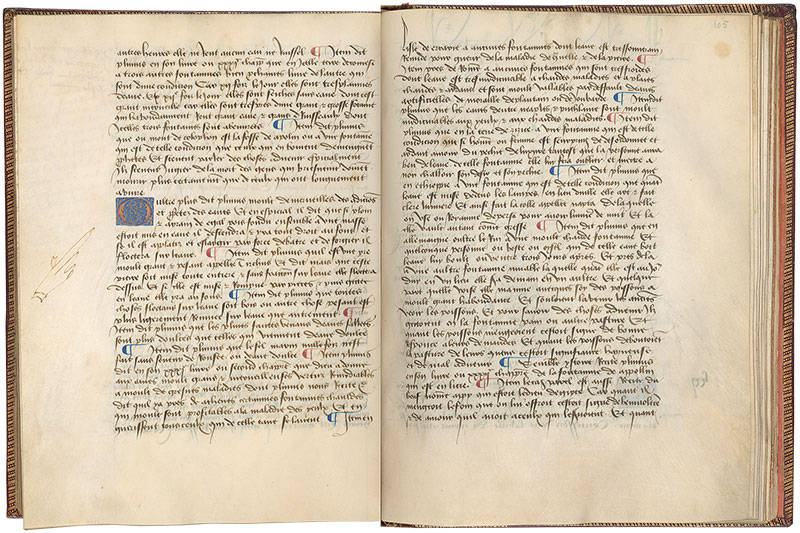
Livre des merveilles du monde
Purchased by J. Pierpont Morgan (1837–1913) in 1911
MS M.461, fols. 105v–106r
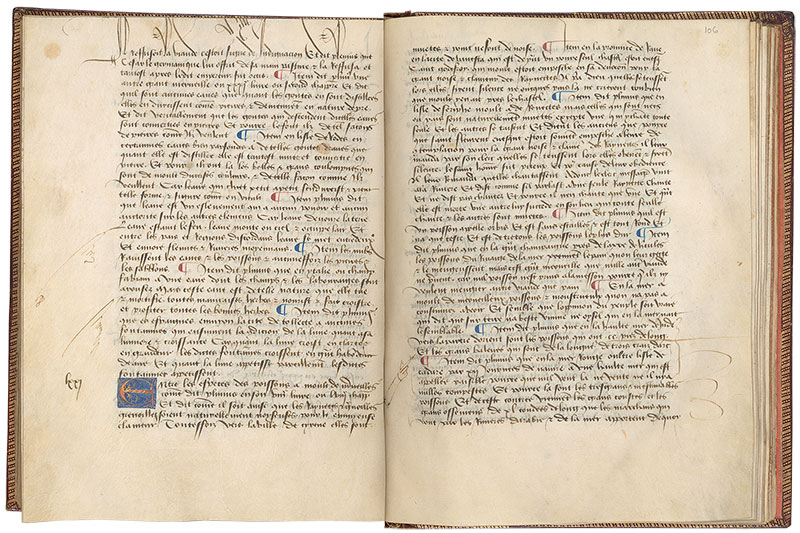
Livre des merveilles du monde
Purchased by J. Pierpont Morgan (1837–1913) in 1911
MS M.461, fols. 106v–107r
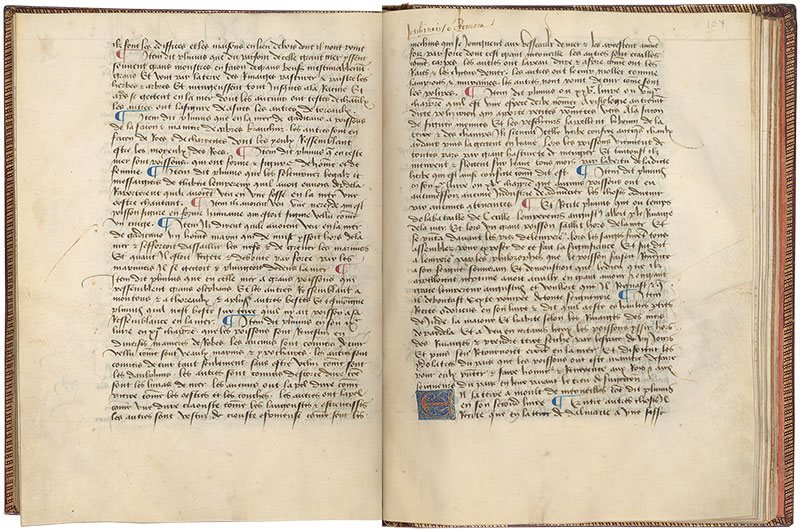
Livre des merveilles du monde
Purchased by J. Pierpont Morgan (1837–1913) in 1911
MS M.461, fols. 107v–108r
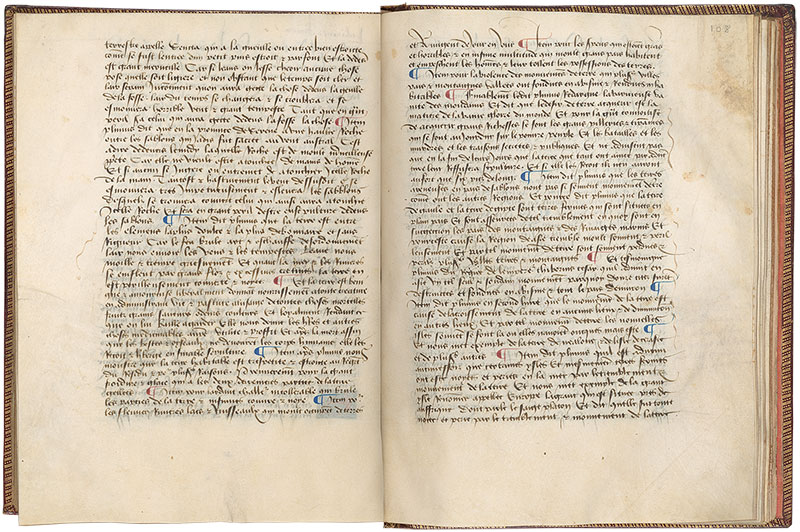
Livre des merveilles du monde
Purchased by J. Pierpont Morgan (1837–1913) in 1911
MS M.461, fols. 108v–109r
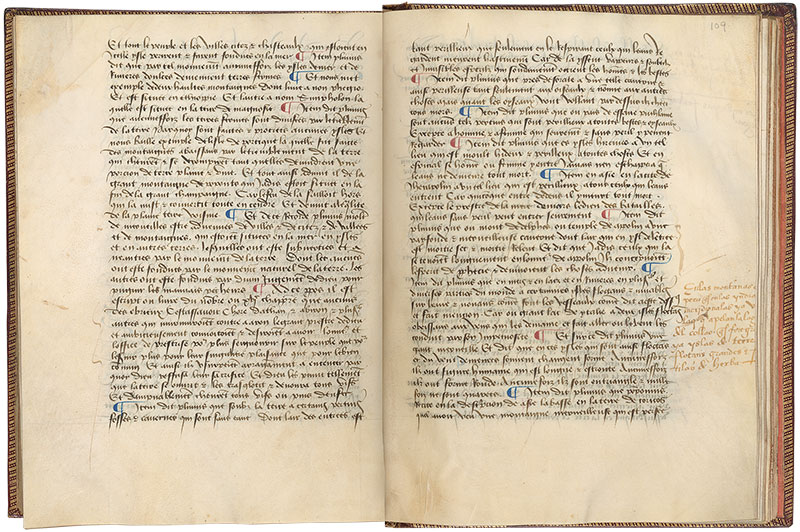
Livre des merveilles du monde
Purchased by J. Pierpont Morgan (1837–1913) in 1911
MS M.461, fols. 109v–110r
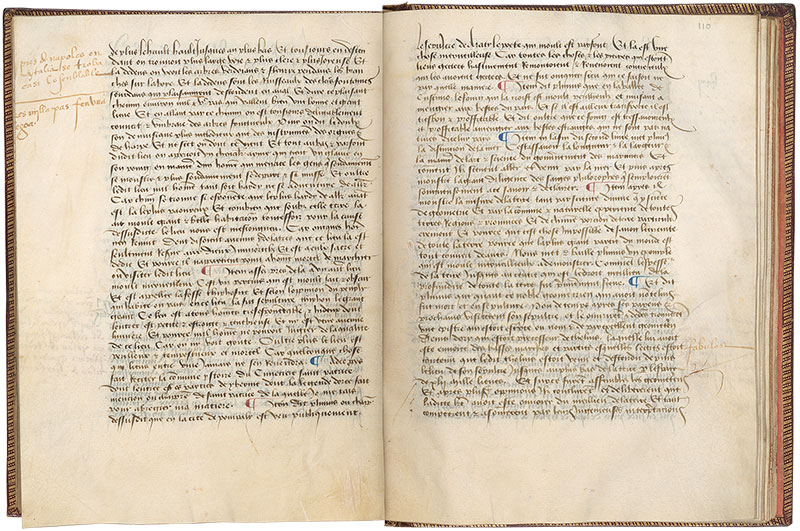
Livre des merveilles du monde
Purchased by J. Pierpont Morgan (1837–1913) in 1911
MS M.461, fols. 110v–111r
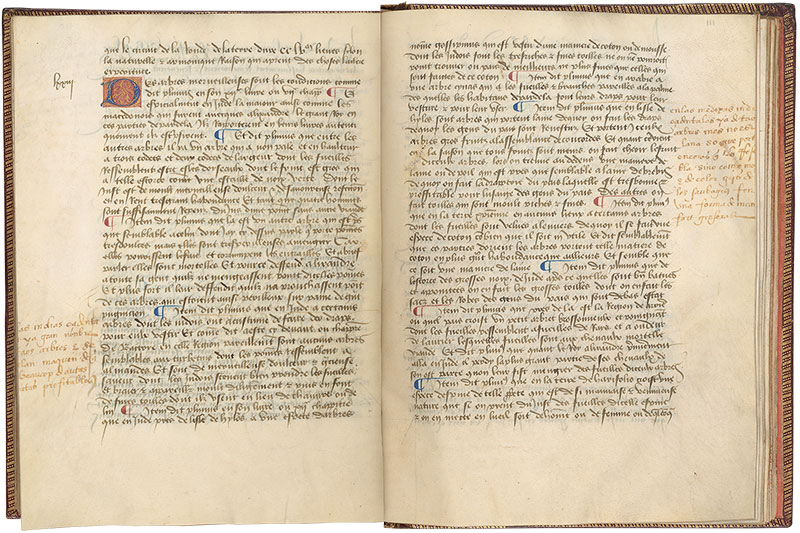
Livre des merveilles du monde
Purchased by J. Pierpont Morgan (1837–1913) in 1911
MS M.461, fols. 111v–112r
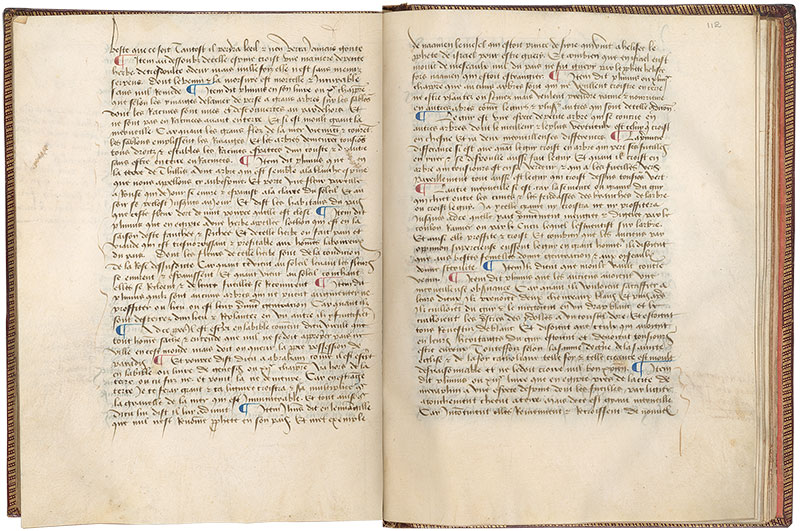
Livre des merveilles du monde
Purchased by J. Pierpont Morgan (1837–1913) in 1911
MS M.461, fols. 112v–113r
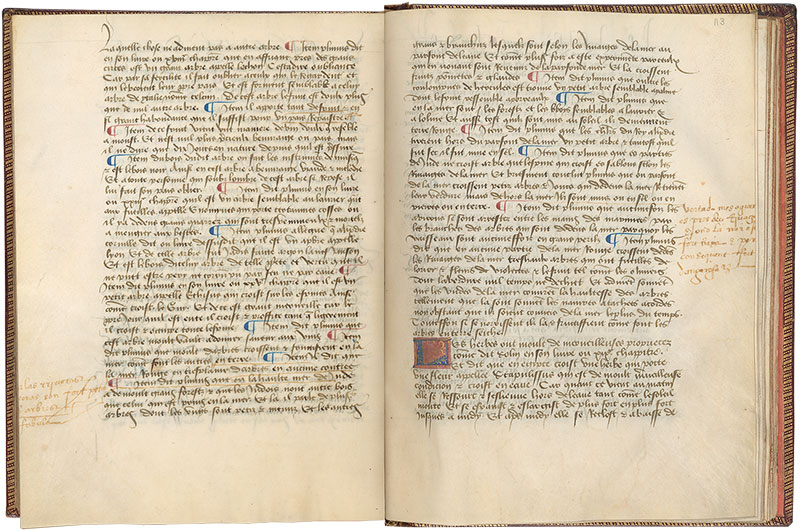
Livre des merveilles du monde
Purchased by J. Pierpont Morgan (1837–1913) in 1911
MS M.461, fols. 113v–114r
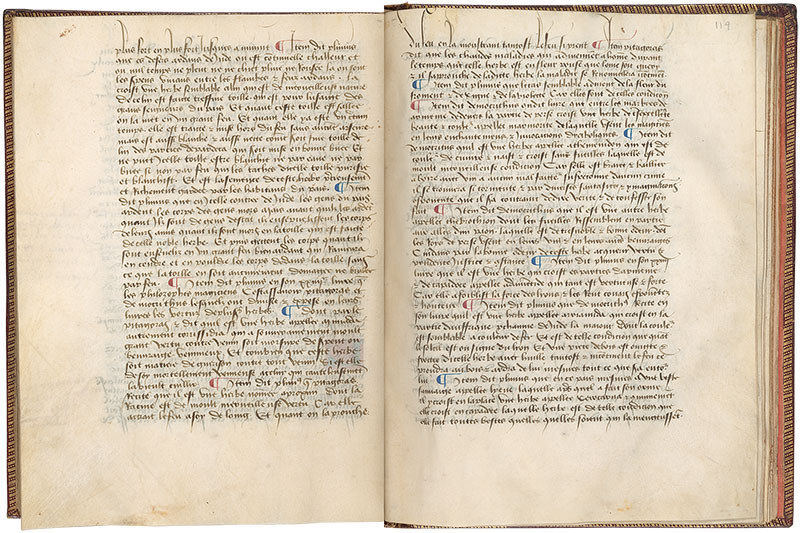
Livre des merveilles du monde
Purchased by J. Pierpont Morgan (1837–1913) in 1911
MS M.461, fols. 114v–115r
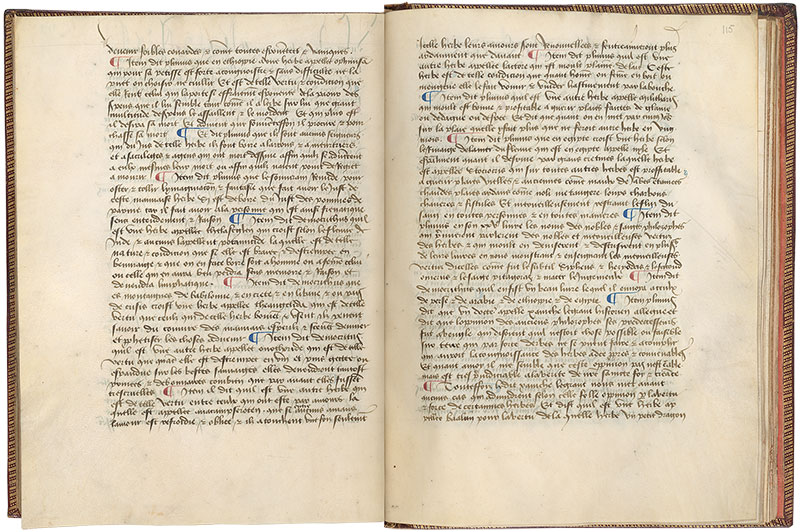
Livre des merveilles du monde
Purchased by J. Pierpont Morgan (1837–1913) in 1911
MS M.461, fols. 115v–116r
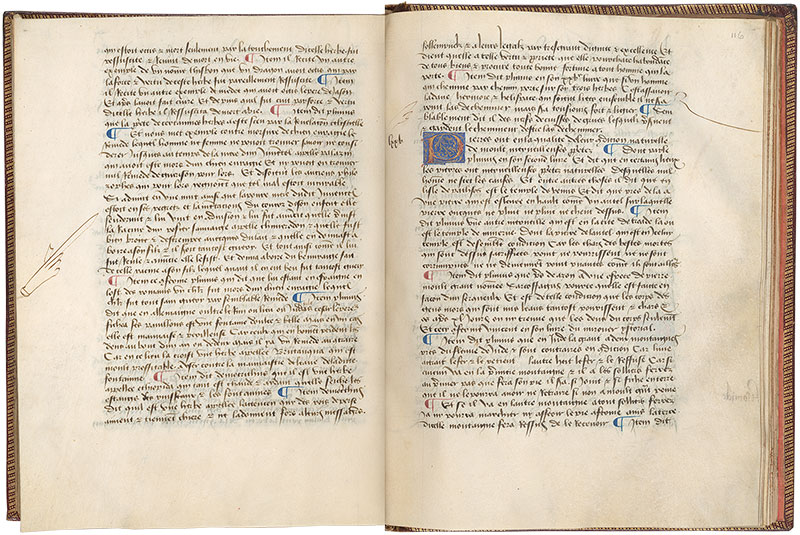
Livre des merveilles du monde
Purchased by J. Pierpont Morgan (1837–1913) in 1911
MS M.461, fols. 116v–117r
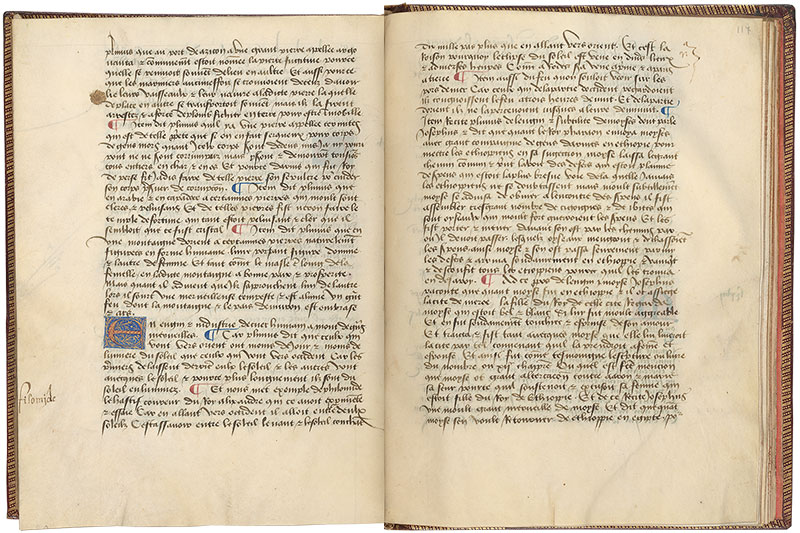
Livre des merveilles du monde
Purchased by J. Pierpont Morgan (1837–1913) in 1911
MS M.461, fols. 117v–118r
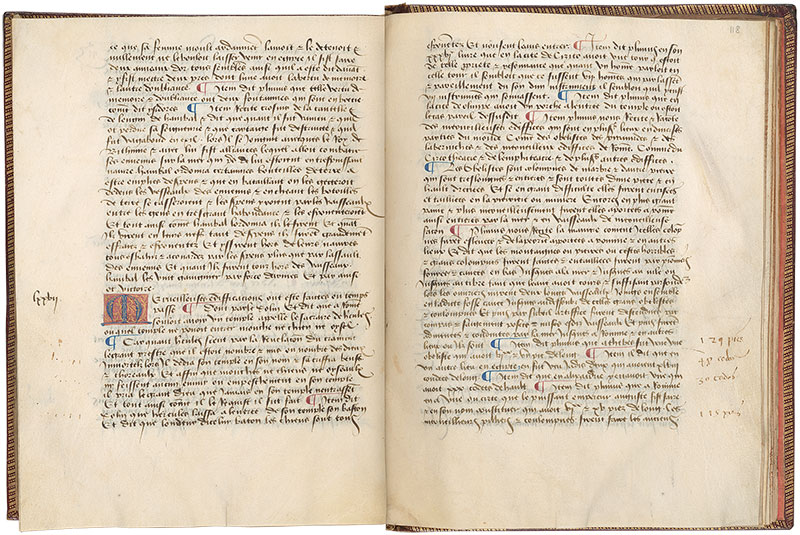
Livre des merveilles du monde
Purchased by J. Pierpont Morgan (1837–1913) in 1911
MS M.461, fols. 118v–119r
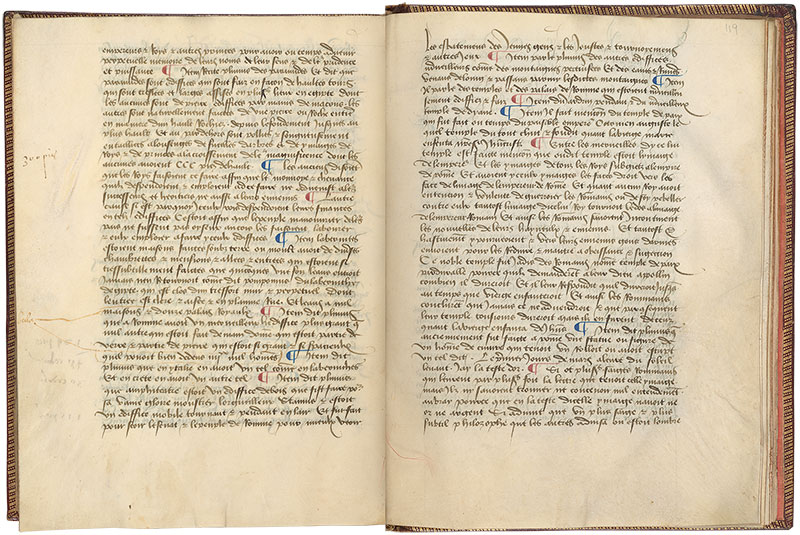
Livre des merveilles du monde
Purchased by J. Pierpont Morgan (1837–1913) in 1911
MS M.461, fols. 119v–120r
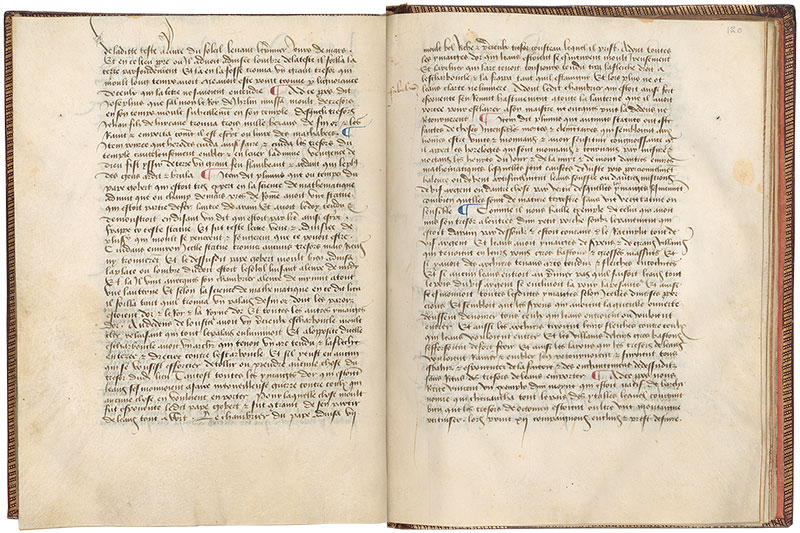
Livre des merveilles du monde
Purchased by J. Pierpont Morgan (1837–1913) in 1911
MS M.461, fols. 120v–121r
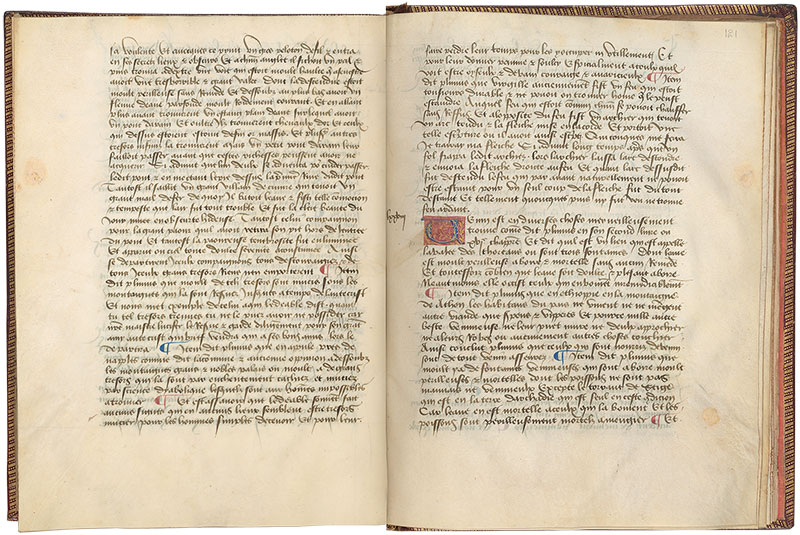
Livre des merveilles du monde
Purchased by J. Pierpont Morgan (1837–1913) in 1911
MS M.461, fols. 121v–122r
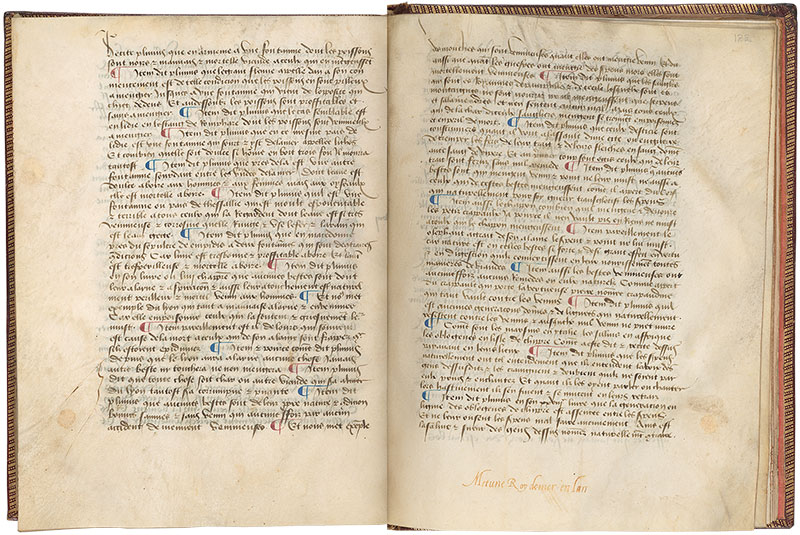
Livre des merveilles du monde
Purchased by J. Pierpont Morgan (1837–1913) in 1911
MS M.461, fols. 122v–123r
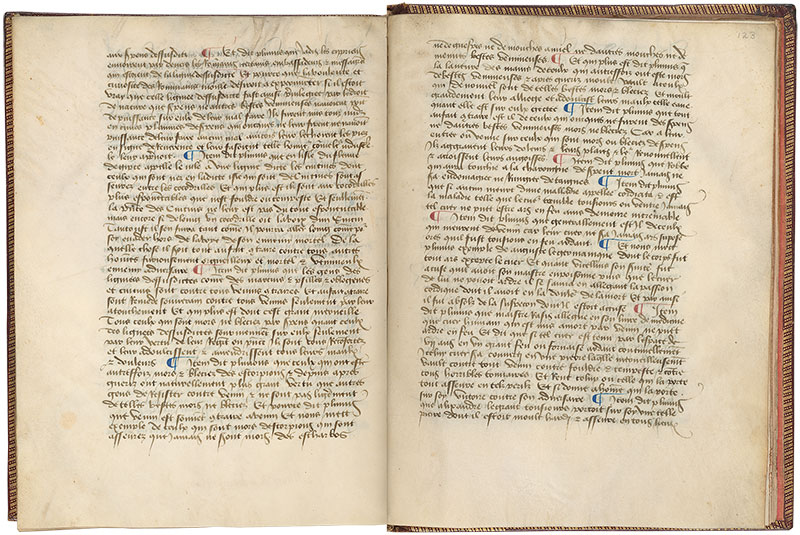
Livre des merveilles du monde
Purchased by J. Pierpont Morgan (1837–1913) in 1911
MS M.461, fols. 123v–124r
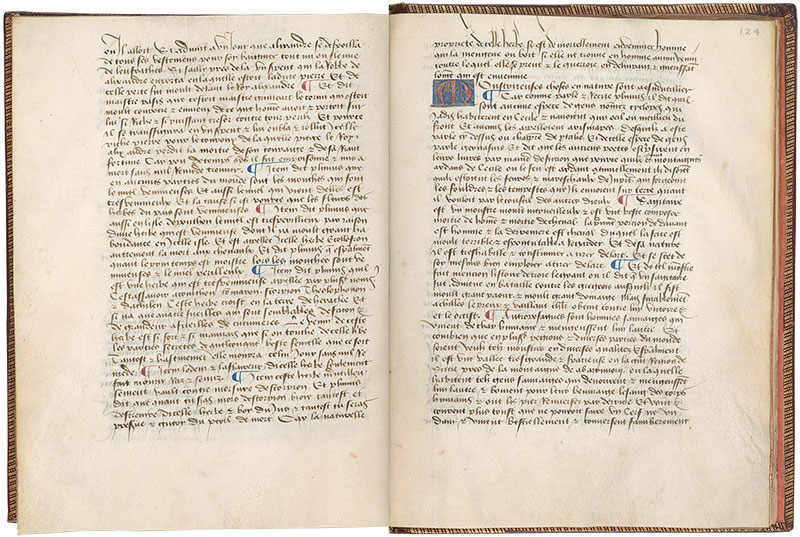
Livre des merveilles du monde
Purchased by J. Pierpont Morgan (1837–1913) in 1911
MS M.461, fols. 124v–125r
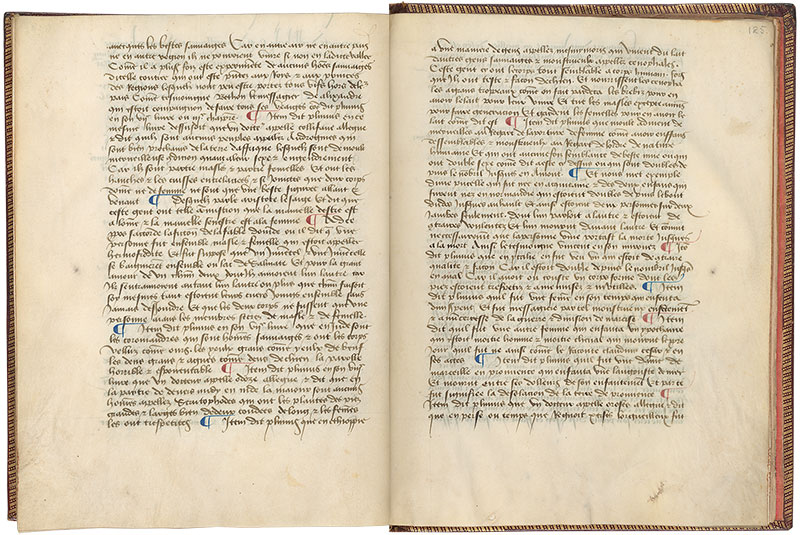
Livre des merveilles du monde
Purchased by J. Pierpont Morgan (1837–1913) in 1911
MS M.461, fols. 125v–126r

Livre des merveilles du monde
Purchased by J. Pierpont Morgan (1837–1913) in 1911
MS M.461, fols. 126v–127r

Livre des merveilles du monde
Purchased by J. Pierpont Morgan (1837–1913) in 1911
MS M.461, fols. 127v–128r
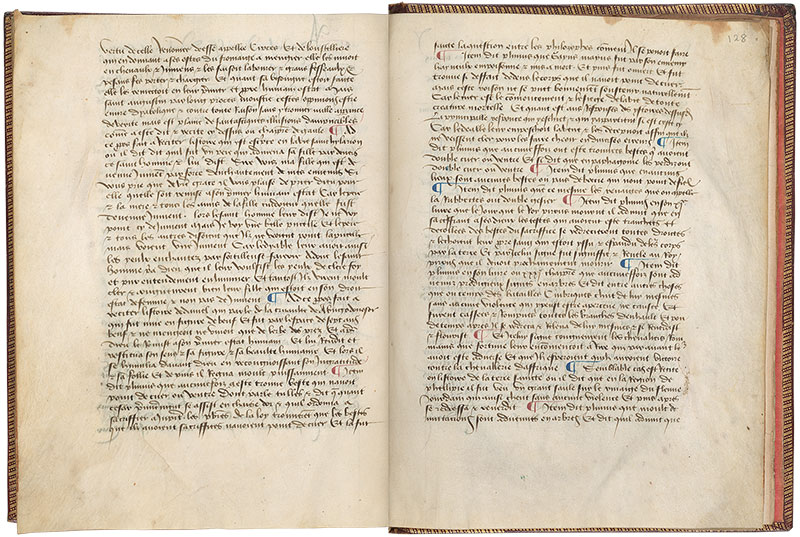
Livre des merveilles du monde
Purchased by J. Pierpont Morgan (1837–1913) in 1911
MS M.461, fols. 128v–129r
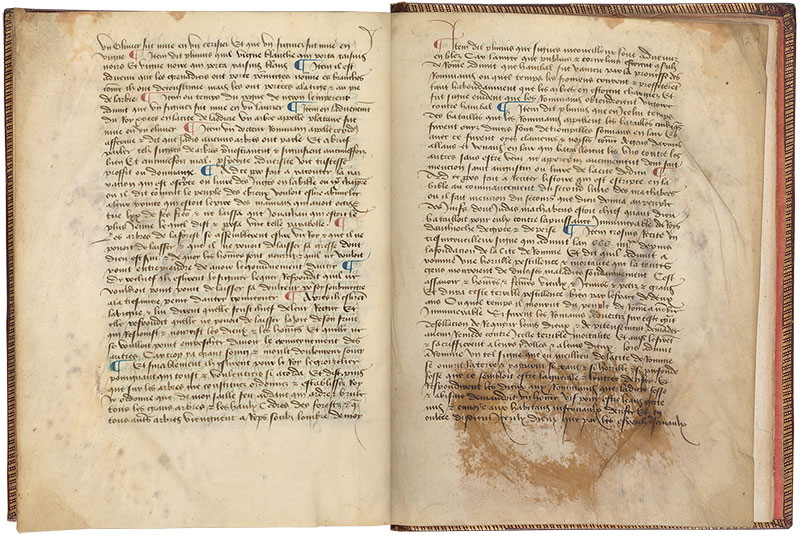
Livre des merveilles du monde
Purchased by J. Pierpont Morgan (1837–1913) in 1911
MS M.461, fols. 129v–[iv]r
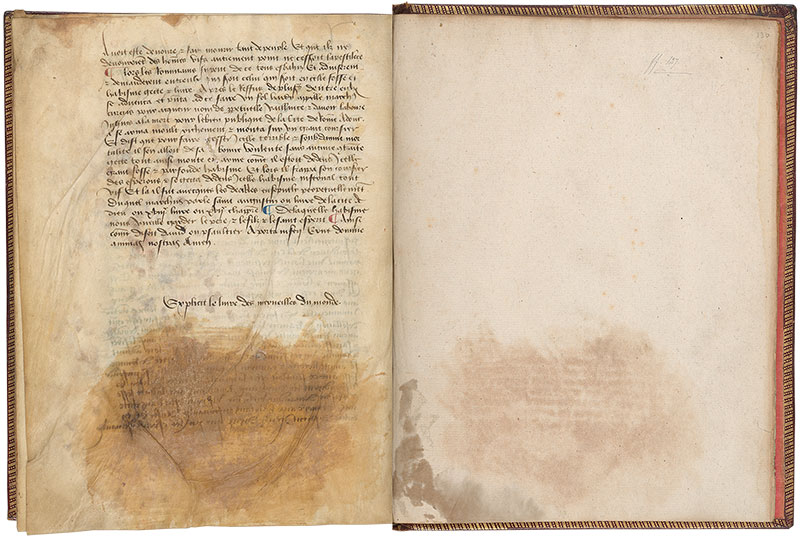
Livre des merveilles du monde
Purchased by J. Pierpont Morgan (1837–1913) in 1911
MS M.461, fols. [iv]v–[v]r
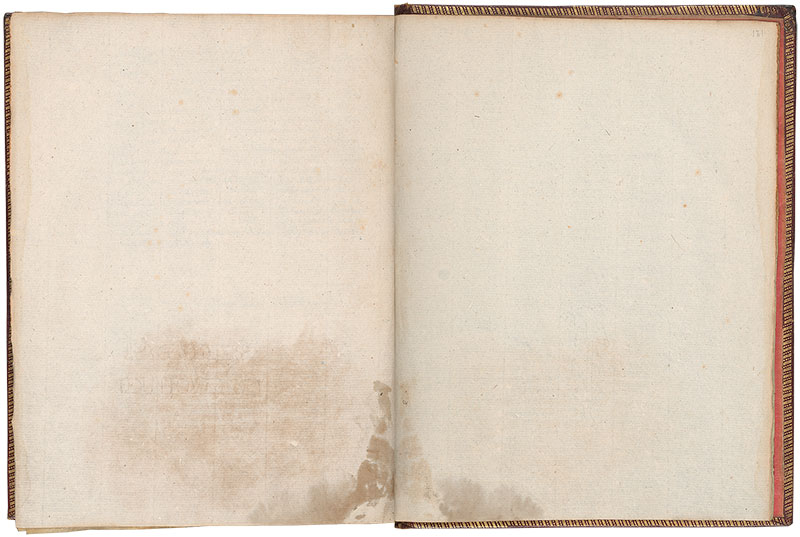
Livre des merveilles du monde
Purchased by J. Pierpont Morgan (1837–1913) in 1911
MS M.461, fols. [v]v–[vi]r
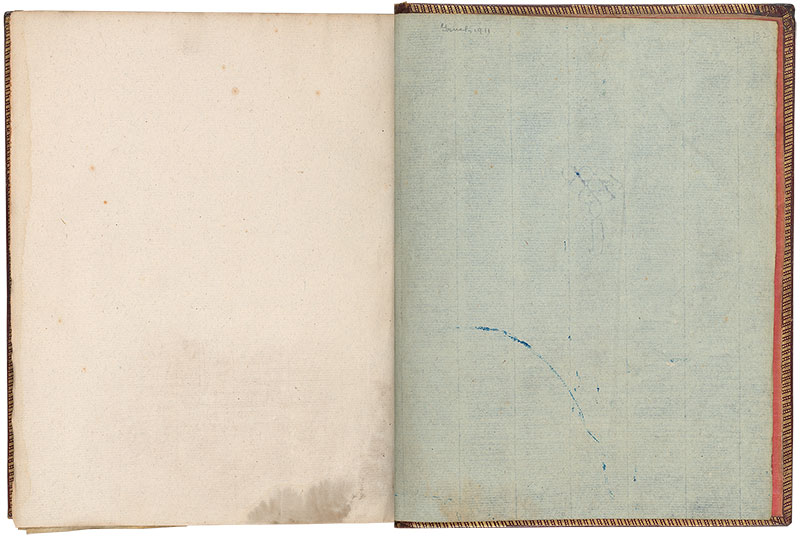
Livre des merveilles du monde
Purchased by J. Pierpont Morgan (1837–1913) in 1911
MS M.461, fol. [vi]v–inside back cover
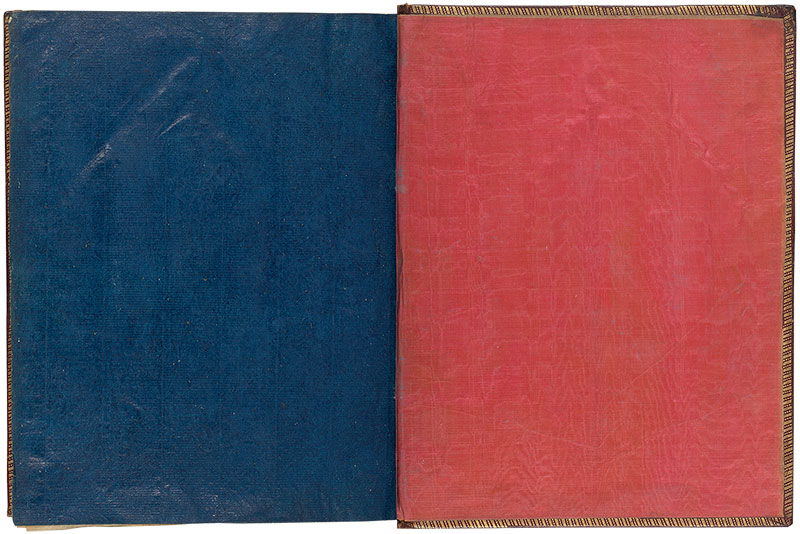
Livre des merveilles du monde
Purchased by J. Pierpont Morgan (1837–1913) in 1911
MS M.461, back cover
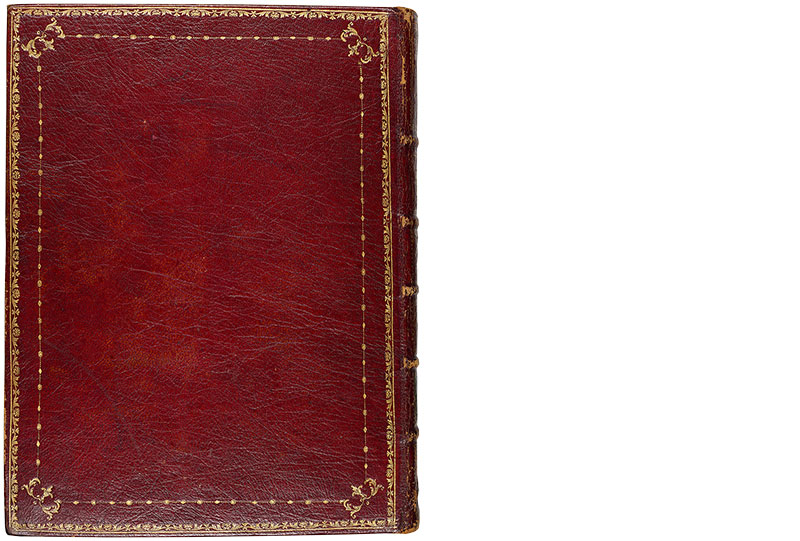
Livre des merveilles du monde
Purchased by J. Pierpont Morgan (1837–1913) in 1911